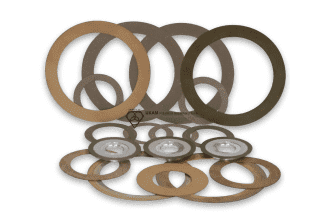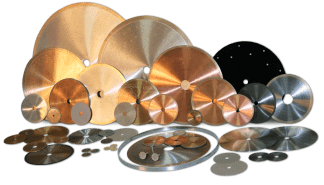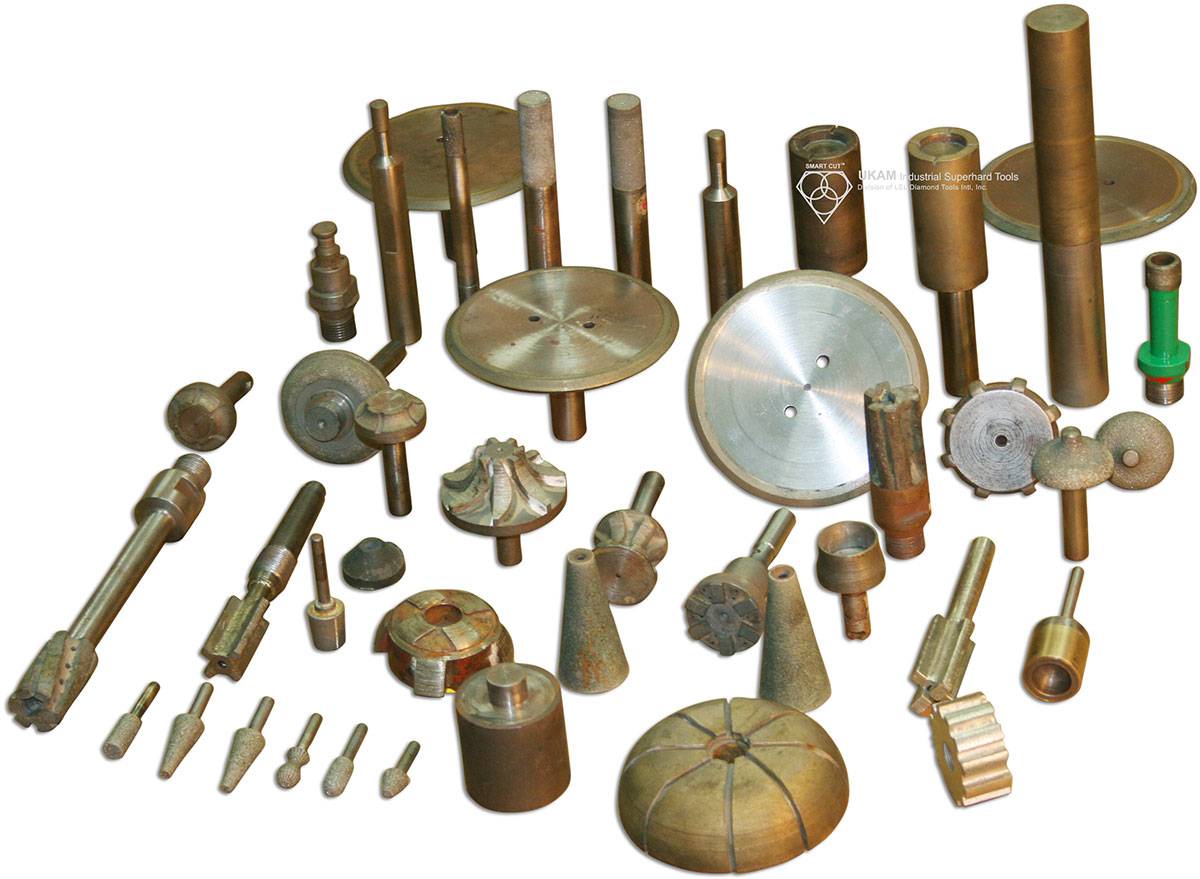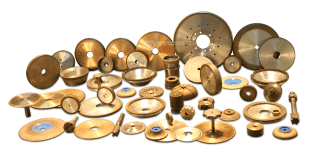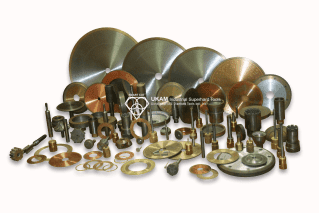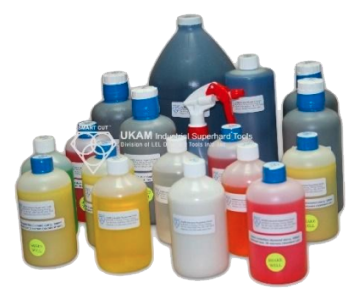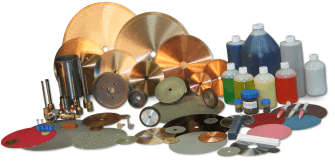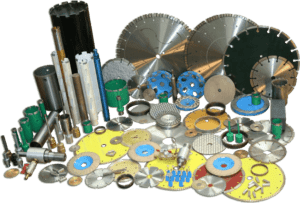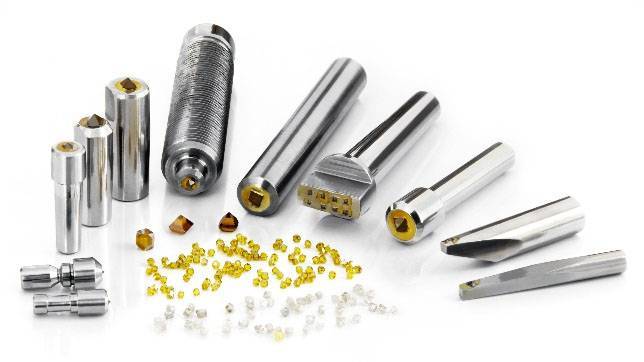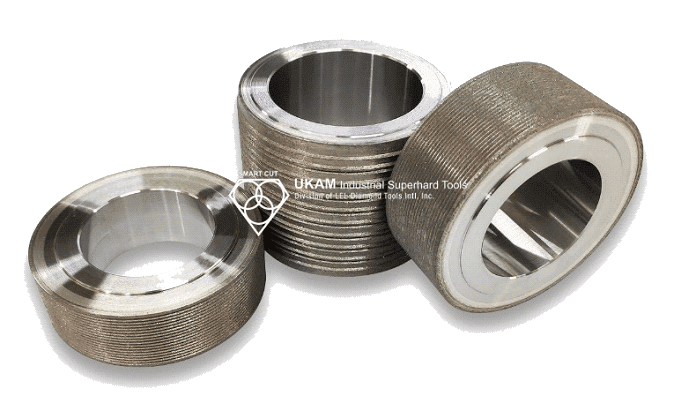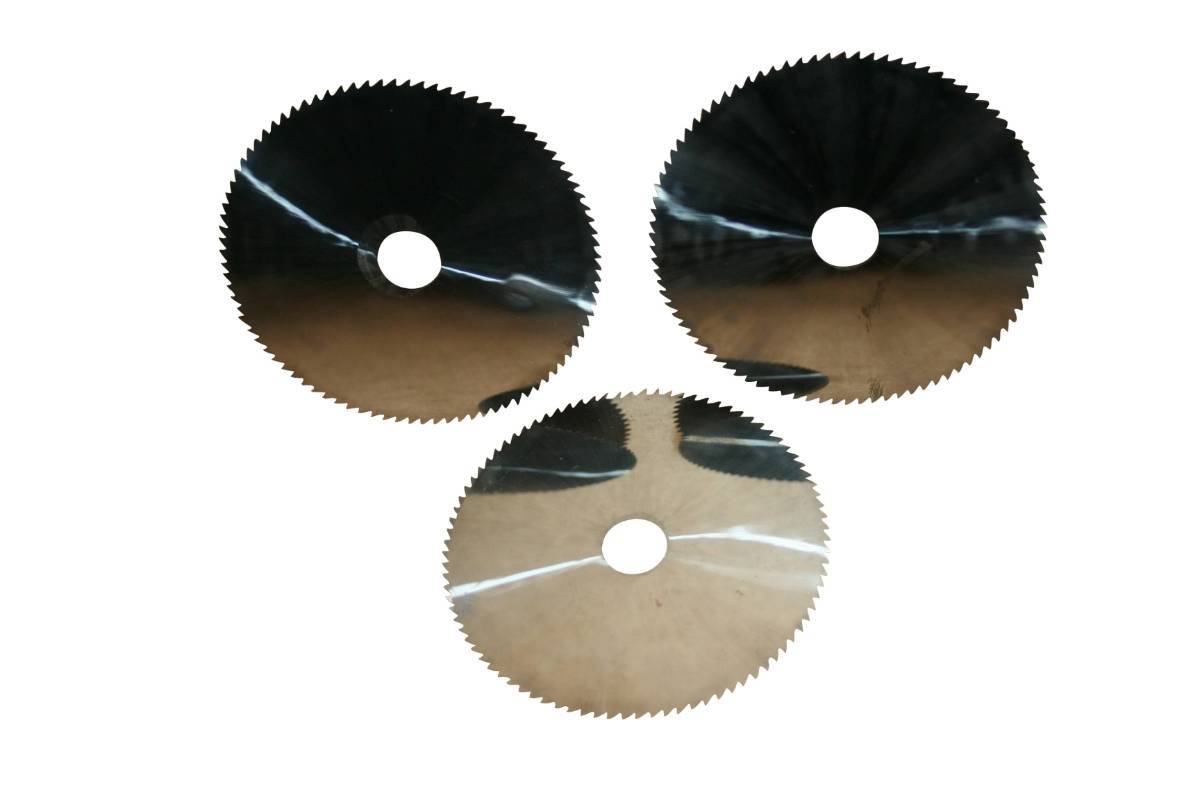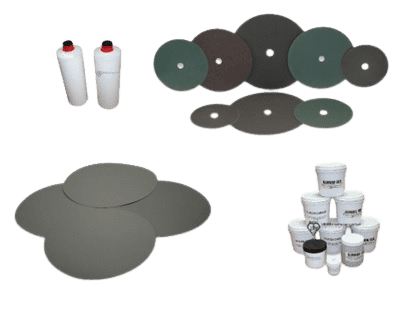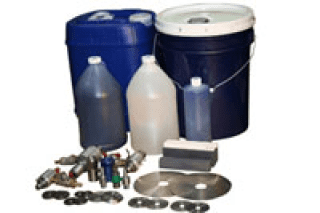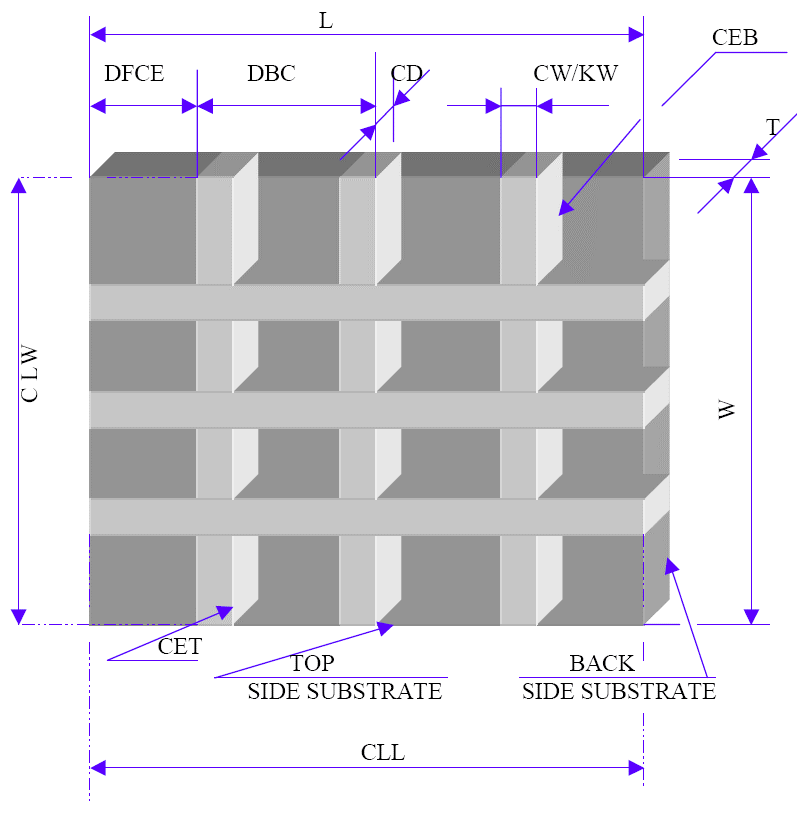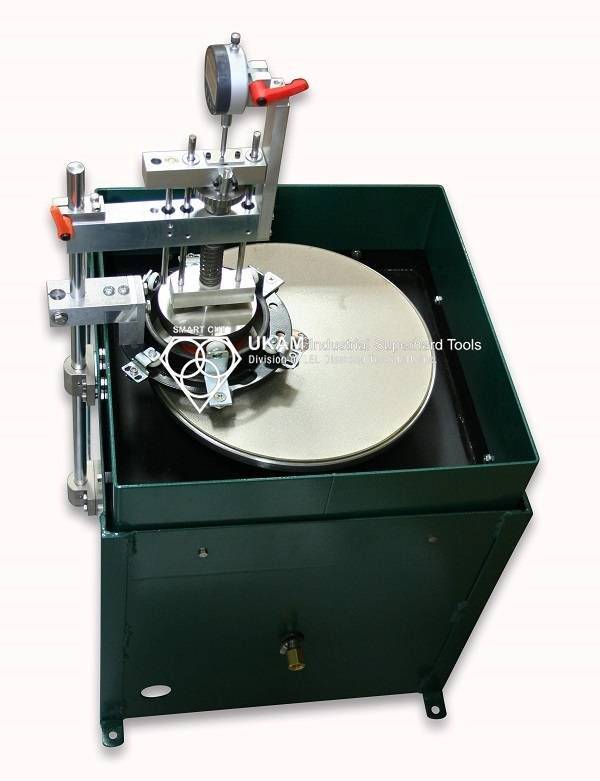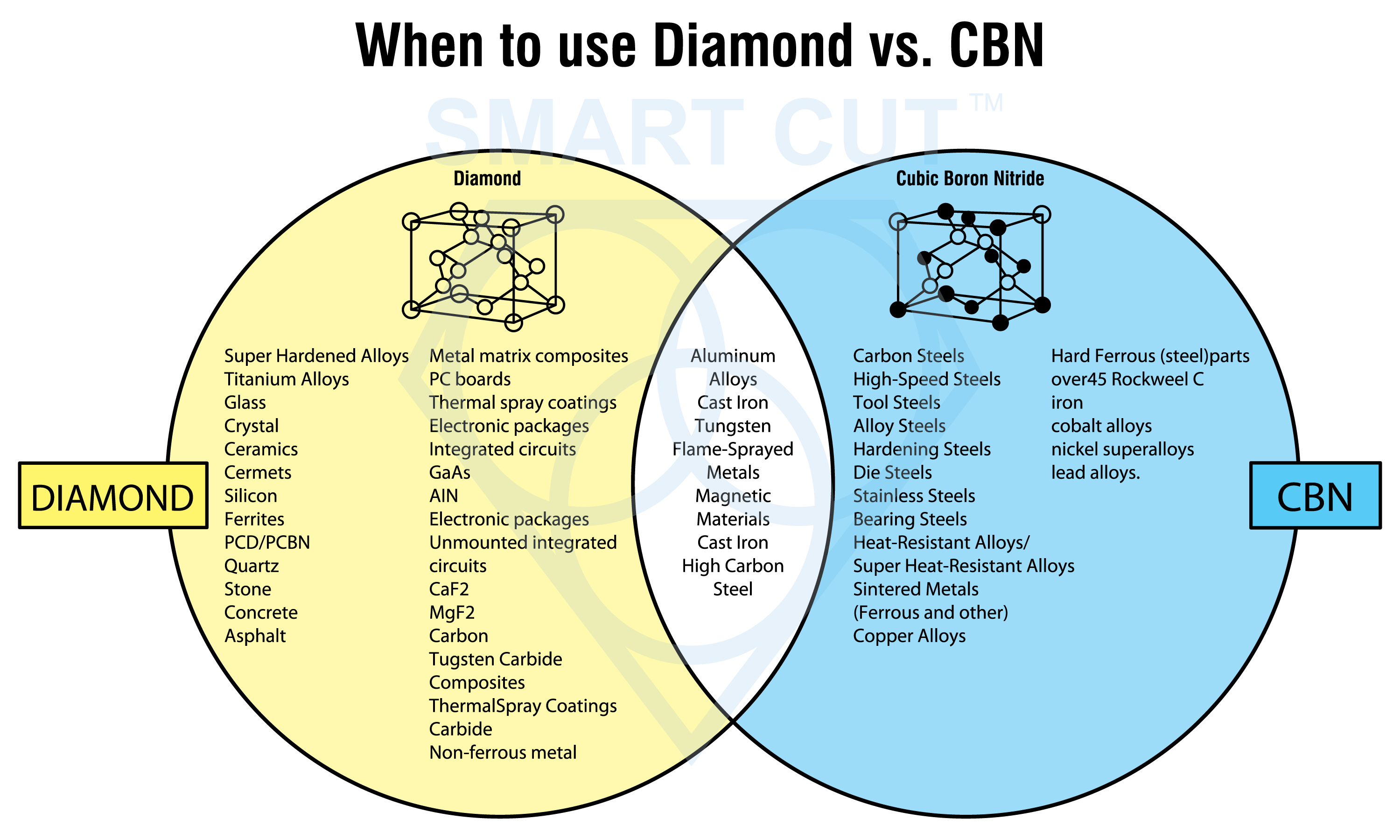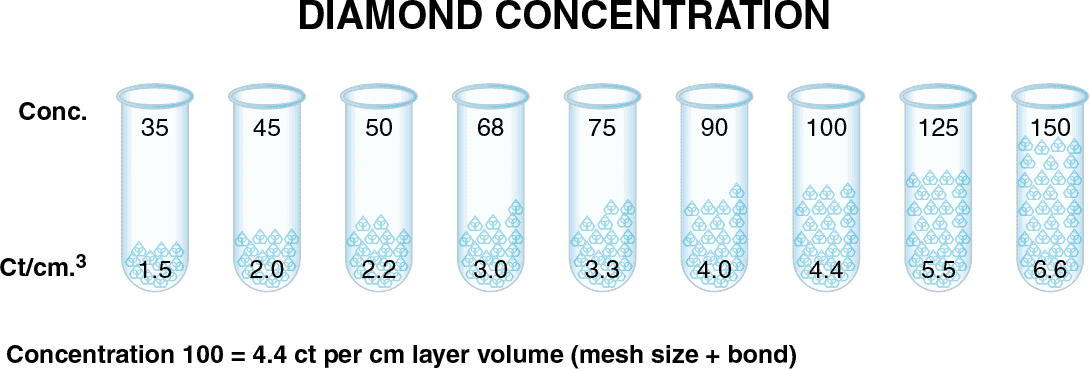Diamond Tool Coolants Why, How, When & Where to Use
-
Posted by
contactor6

Coolant is one of the most overlooked variables in the overall diamond or cbn tool machining process. Effective and proper use of coolant and recalculating coolant system will pay off in terms of improved surface finish quality, increased tool life and more consistent cutting results. Coolant does more than just cool the blade and material, its other more important roles include: lubrication, flush away swarf particles.
The effective use of coolants with diamond or cbn tools is crucial for optimizing performance, enhancing tool life, and insuring consistency.. Whether it's for heat management, lubrication, or debris removal, coolants play a pivotal role in ensuring the success of diamond or cbn tool operations. This article will delve into the essential aspects of using coolants with diamond tools, exploring the why, how, when, and where of coolant application.
Share this Article with Friend or Colleague
Why Use Coolants?
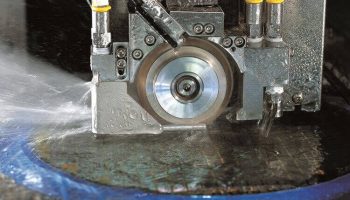
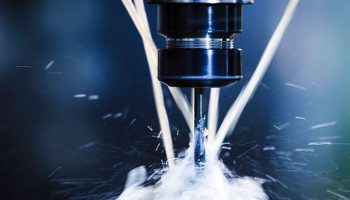
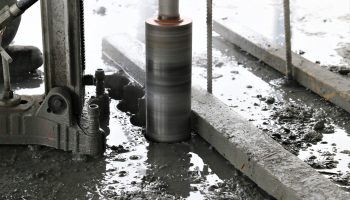
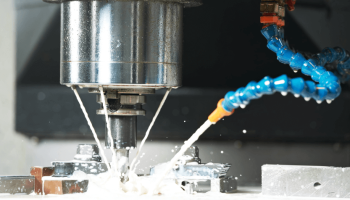
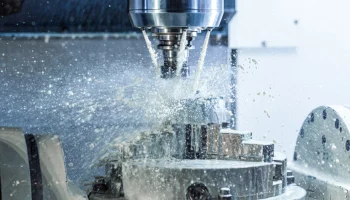
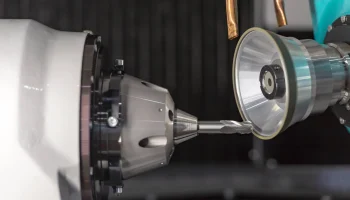
Coolants significantly enhance productivity, improve cut quality, preserve true material microstructure, minimize material deformation, increase tool life, and enhance operational consistency. In modern industrial settings, diamond tools typically operate at higher speeds, generating significant amounts of heat. Coolants are vital for controlling heat generation and enhancing tool performance. They disperse and flush out material particles from the kerf, thereby preventing material chipping and internal cracking, which in turn improves material yield and reliability while extending tool life. Additionally, using coolants eliminates the need for secondary cleaning or processing operations, reducing operational costs.
Coolants reduce surface tension, bond water molecules, and penetrate the kerf, preventing the material from sticking to the tool and enhancing the surface finish.
Moreover, coolants provide the necessary lubrication to reduce friction between the tool and the material, protecting the material from sticking to the tool.

Coolants increase productivity and the quality of material, preserve true material microstructure, and minimize material deformation. They extend the time interval between tooling changes, saving money by reducing the number of tool or die changes needed. Fewer tooling changes increase productivity by minimizing production line shutdowns.
Modern coolants fulfill two primary functions: cooling and lubrication. Both are crucial, but their relative importance depends on the type of operation and material being processed.

Cooling
Prior to modern high-speed equipment, cooling from a lubricant was not needed because slow cutting speeds did not generate much heat. Straight lubricants were sufficient to transfer enough heat to avoid damage to parts and tools. However, modern equipment operates at high speeds, generating substantial heat that must be removed by the coolant. Failure to remove the heat and chips in the contact zone between the cutting tool and the part will shorten tool life, increase the number of tool changes, and reduce tooling and part tolerances due to thermal expansion.
Lubrication
Lubrication from the coolant reduces friction between the tool and material or substrate. reducing friction and enhancing cutting efficiency. This lubrication helps in minimizing wear and tear on the tool, thus prolonging its lifespan.
The coolant prevents the material from sticking to the tool and enhances the surface finish. While some companies attempt to eliminate coolants, they often end up increasing tooling costs and suffering lost production. However, some companies still choose to avoid coolants, seeing it as a cost-saving measure despite the potential downsides. Nonetheless, such companies are in the minority.
Heat Management:
Diamond tools generate significant heat due to friction during cutting, grinding, or drilling. This heat can damage the tool and the workpiece, leading to thermal cracks, material degradation, or even tool failure. Coolants help to dissipate this heat effectively.
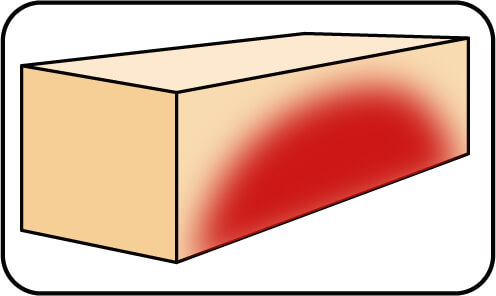
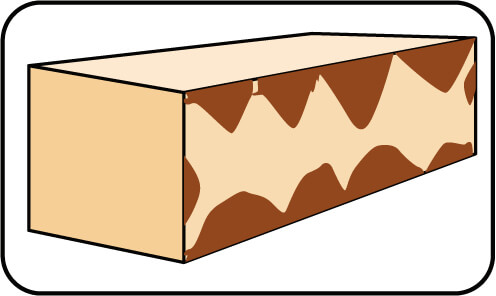
Debris Removal:
During the cutting or grinding process, materials produce fine debris and swarf that can clog the tool and affect its performance. Coolants help to wash away this debris, keeping the cutting surface clean and ensuring consistent performance.

Surface Finish:
The use of coolants improves the surface finish of the processed material by reducing friction and preventing material smearing or burning. This is particularly crucial in applications requiring high-quality finishes, such as optics or precision engineering.
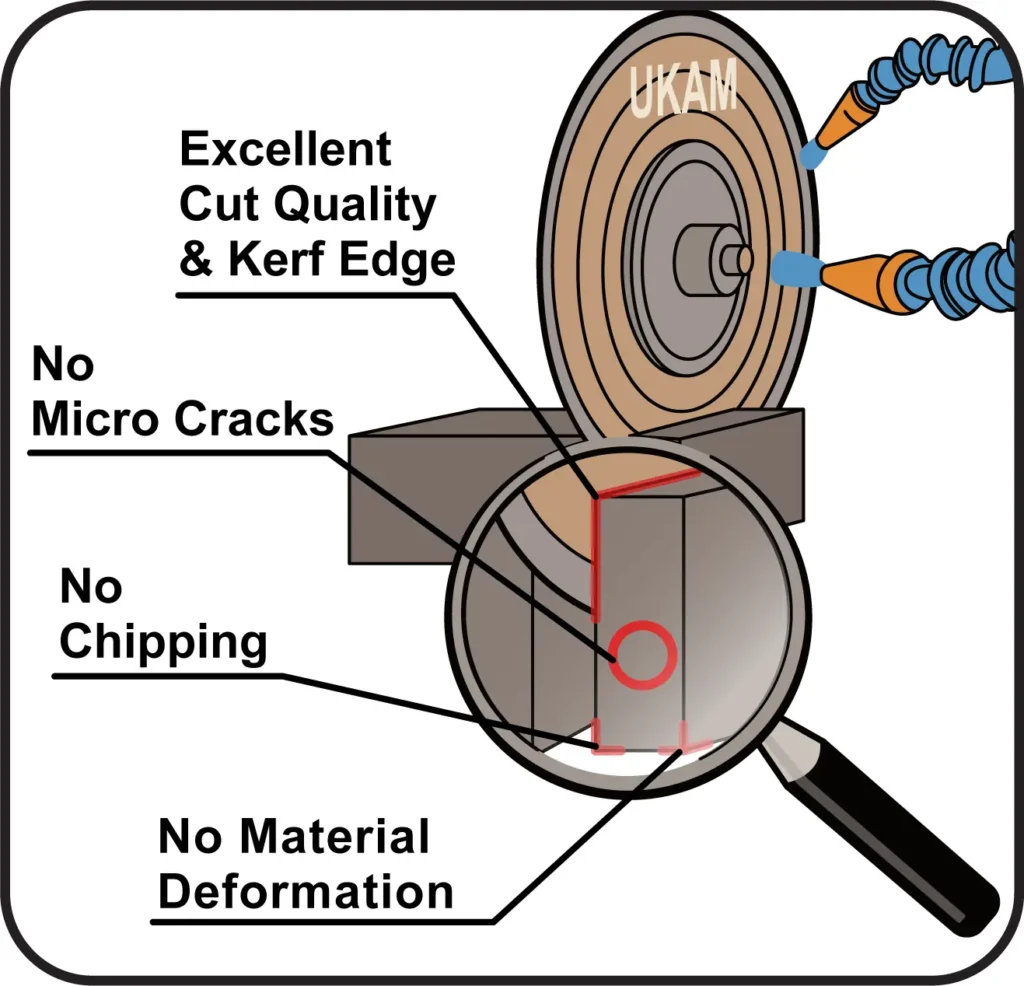
What are the Advantages of Using Coolants?

-
 1. Reduces Surface Tension - Coolant reduces the surface tension, improving cutting performance.
1. Reduces Surface Tension - Coolant reduces the surface tension, improving cutting performance.
-
 2. Bonds Water Molecules - The coolant bonds water molecules, aiding in better cutting.
2. Bonds Water Molecules - The coolant bonds water molecules, aiding in better cutting.
-
 3. Prevents Swarf Accumulation - Coolant helps prevent the buildup of debris or swarf during cutting, leading to cleaner cuts.
3. Prevents Swarf Accumulation - Coolant helps prevent the buildup of debris or swarf during cutting, leading to cleaner cuts.
-
 4. Extend Blade Life - Using coolant can prolong the lifespan of the blade.
4. Extend Blade Life - Using coolant can prolong the lifespan of the blade.
-
 5. Improve Material Yield and Reliability - Coolant enhances the yield and reliability of the materials being cut.
5. Improve Material Yield and Reliability - Coolant enhances the yield and reliability of the materials being cut.
-
 6. Eliminate Additional Material Processing -Coolant usage can eliminate the need for additional processing steps due to better cutting performance.
6. Eliminate Additional Material Processing -Coolant usage can eliminate the need for additional processing steps due to better cutting performance.
-
 7. Improves Internal Tolerances - Coolant improves the internal tolerances of the materials, resulting in more precise cuts.
7. Improves Internal Tolerances - Coolant improves the internal tolerances of the materials, resulting in more precise cuts.
-
 8. Reduces Edge Damage - Coolant minimizes edge damage during cutting.
8. Reduces Edge Damage - Coolant minimizes edge damage during cutting.
-
 9. Minimizes Internal Cracking - Using coolant reduces the risk of internal cracking in materials during cutting.
9. Minimizes Internal Cracking - Using coolant reduces the risk of internal cracking in materials during cutting.
-
 10. Assures Long - term Integrity of Material - Coolant ensures the long-term integrity of the material being cut.
10. Assures Long - term Integrity of Material - Coolant ensures the long-term integrity of the material being cut.
Using with SMART CUT coolant

Cutting With Plain Water

What are the Disadvantages of just using plain water?
While water is a common coolant used in various machining and grinding operations, it has significant limitations when used alone in diamond tool applications. The use of plain water as a coolant can lead to a series of issues that impact the performance of the diamond tool, the quality of the processed material, and the overall efficiency of the operation.
Material particles and debris build up around the kerf, creating a barrier between the coolant and the material. Water is not able to effectively relieve the amount of heat generated by the cutting process. Material debris formerly dispersed by the coolant now clogs the pores of the bond matrix, preventing the diamond crystals held in the bond matrix from effectively grinding into the material.
DISADVANTAGES OF USING PLAIN WATER:
-
 1. Material Chipping - Using plain water can lead to chipping of the material during cutting.
1. Material Chipping - Using plain water can lead to chipping of the material during cutting.
-
 2. Cracking - Plain water may cause cracking in the material.
2. Cracking - Plain water may cause cracking in the material.
-
 3. Smearing - The use of plain water can result in smearing of the material.
3. Smearing - The use of plain water can result in smearing of the material.
-
 4. Burning - There is a risk of burning the material when using plain water.
4. Burning - There is a risk of burning the material when using plain water.
-
 5. Material Deformation - Plain water can lead to unwanted deformation of the material being cut.
5. Material Deformation - Plain water can lead to unwanted deformation of the material being cut.
-
 6. Material Contamination - Using plain water may cause contamination of the material.
6. Material Contamination - Using plain water may cause contamination of the material.
-
 7. Poor and Inconsistent Tool Performance - Plain water can result in suboptimal and inconsistent performance of the cutting tool.
7. Poor and Inconsistent Tool Performance - Plain water can result in suboptimal and inconsistent performance of the cutting tool.
-
 8. Shorter Tool Life - The lifespan of the tool may be reduced when using plain water.
8. Shorter Tool Life - The lifespan of the tool may be reduced when using plain water.
-
 9. Many Other Undesired Outcomes - Plain water can lead to various other undesirable outcomes during cutting.
9. Many Other Undesired Outcomes - Plain water can lead to various other undesirable outcomes during cutting.
1. Inadequate Debris Removal
During cutting, grinding, or drilling processes, the material being processed produces fine particles and debris. When using plain water as a coolant, these material particles tend to accumulate around the kerf—the narrow slit created during cutting. This buildup creates a barrier that prevents water from effectively reaching the material and the cutting surface, which compromises the cooling and lubricating function.
Additionally, water does not possess the same dispersing capabilities as specialized coolants, which means that material debris formerly dispersed by proper coolant now clogs the pores of the bond matrix. This impedes the exposure of fresh diamond crystals, thereby reducing the tool’s cutting efficiency.
2. Ineffective Heat Dissipation
One of the primary functions of a coolant is to absorb and dissipate the heat generated during the cutting process. Water, though a good conductor of heat, lacks the specialized additives found in formulated coolants that enhance thermal conductivity and heat absorption. As a result, water alone is not able to effectively relieve the amount of heat generated, leading to overheating. Overheating can cause thermal damage to both the tool and the material, resulting in issues such as:
-
 Tool Damage: Excessive heat can degrade the bond matrix, cause thermal cracking, or lead to premature wear of the diamond segments.
Tool Damage: Excessive heat can degrade the bond matrix, cause thermal cracking, or lead to premature wear of the diamond segments.
-
 Material Damage: Overheating can lead to thermal damage of the processed material, such as burning, melting, or warping.
Material Damage: Overheating can lead to thermal damage of the processed material, such as burning, melting, or warping.
3. Lack of Lubrication
Water does not possess adequate lubricating properties. In diamond tool operations, lubrication is crucial to reduce friction between the cutting surface and the material. The lack of lubrication can lead to:
-
 Increased Friction: This not only generates more heat but also increases tool wear.
Increased Friction: This not only generates more heat but also increases tool wear.
-
 Surface Imperfections: Without lubrication, the tool may cause micro-scratches or other imperfections on the surface of the material, impacting the final quality.
Surface Imperfections: Without lubrication, the tool may cause micro-scratches or other imperfections on the surface of the material, impacting the final quality.
4. Corrosion Issues
Water alone can cause corrosion to both the tool and the equipment. While specialized coolants contain additives to prevent rust and corrosion, plain water lacks these protective components. This can lead to:
-
 Tool Corrosion: Corrosion can damage the diamond tool, impacting its performance and lifespan.
Tool Corrosion: Corrosion can damage the diamond tool, impacting its performance and lifespan.
-
 Equipment Corrosion: Water can corrode the equipment, leading to maintenance issues, increased downtime, and potential equipment failure.
Equipment Corrosion: Water can corrode the equipment, leading to maintenance issues, increased downtime, and potential equipment failure.
5. Shortened Tool Life
The combination of inadequate debris removal, ineffective heat dissipation, lack of lubrication, and potential corrosion all contribute to a shortened tool life when using plain water as a coolant. The diamond tool wears out more quickly, leading to increased costs and downtime associated with frequent tool changes and replacements.
Why Reducing and Minimizing Heat Generation is Important?
Heat management is a critical factor in the use of diamond tools, given the extreme conditions they often operate under. Diamond tools, known for their unparalleled hardness and cutting efficiency, generate substantial heat during cutting, grinding, or drilling processes. This heat primarily results from friction between the diamond surface and the material being processed. If not managed properly, this heat can lead to a series of detrimental effects on both the tool and the workpiece.
Excessive heat can lead to thermal cracks in both the tool and the material being processed. These cracks occur when the material expands unevenly due to heat, resulting in internal stresses. Thermal cracks can compromise the integrity of the workpiece or cause premature tool failure.
Prolonged exposure to high temperatures can degrade the material being processed. This is particularly problematic when working with heat-sensitive materials, such as composites or certain ceramics. Material degradation can result in weakened structural integrity, discoloration, or altered physical properties.
Overheating can cause the diamond section to lose their bond or the tool to wear unevenly. The excessive heat can soften the bond holding the diamond particles, leading to rapid tool wear or loss of cutting ability. In extreme cases, the tool can fail catastrophically, posing a safety risk.
Coolants are essential for managing the heat generated during diamond tool operations. Their role in heat management is multi-faceted. Coolants act as thermal conductors, absorbing and carrying away heat generated during the cutting or grinding process. The continuous flow of coolant ensures that the tool and the workpiece remain at an optimal temperature, preventing overheating.
Coolants also serve as lubricants, reducing friction between the tool and the material. Reduced friction translates to less heat generation, further contributing to effective heat management. Additionally, by maintaining a consistent temperature, coolants prevent thermal shock, which can occur when the tool or material experiences sudden temperature changes. Thermal shock can lead to cracking or warping, but proper coolant application helps maintain thermal stability.
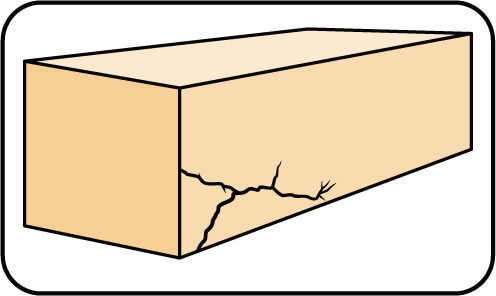


Why Material Debris/Swarf Removal is Important?
During the cutting or grinding process with diamond tools, fine debris and swarf are produced as a natural byproduct. This debris can pose significant challenges if not managed effectively, as it can interfere with the tool's performance, clogging the cutting surface and affecting the overall efficiency of the operation. Proper coolant application is crucial for effective debris removal, as it helps to maintain a clean cutting surface and ensure consistent performance.
The debris generated during diamond tool operations primarily consists of tiny particles of the material being processed, along with worn-down particles from the tool itself. This mixture, known as swarf, can quickly accumulate on the cutting surface and in the spaces between the diamond particles. When debris accumulates on the cutting surface, it can lead to a range of issues. Firstly, the accumulation of debris interferes with the diamond surface's ability to interact effectively with the material. This reduced interaction can result in slower cutting speeds and increased resistance, affecting overall productivity.
Secondly, swarf can clog the tool, obstructing the cutting or grinding process. Clogged tools are less efficient and can overheat more quickly, which in turn can damage the tool or the workpiece. Thirdly, the presence of debris can lead to surface imperfections on the processed material. These imperfections are particularly problematic in precision applications where a high-quality finish is essential. Additionally, debris can accelerate tool wear by creating additional friction and abrasive contact points. Increased tool wear reduces the lifespan of the diamond tool, leading to higher operational costs.
Coolants play a pivotal role in managing debris during diamond tool operations. Their benefits in this context include providing a continuous flow of liquid that helps to wash away debris from the cutting surface. This flushing action prevents the accumulation of swarf, keeping the cutting surface clean and allowing for efficient cutting or grinding. Coolants often contain additives that help to suspend particles, keeping them away from the cutting surface.
This suspension prevents the debris from settling back onto the tool or the material, maintaining a clean and effective cutting environment. Coolants also provide lubrication that helps to reduce friction and prevent debris from adhering to the cutting surface. This lubrication keeps the tool functioning smoothly and reduces the likelihood of debris causing damage or clogging. Additionally, coolants provide cooling, which reduces the thermal expansion of the material and the tool. This cooling effect prevents debris from becoming welded or stuck to the cutting surface due to heat, further aiding in debris removal.
To maximize the effectiveness of coolants in debris removal, several best practices should be followed. The coolant flow rate should be sufficient to flush away debris effectively. Inadequate flow rates can lead to insufficient cleaning, while excessive flow rates can cause splashing or coolant waste.
Filtration systems should be used to remove debris from the coolant, ensuring that clean coolant is continuously supplied to the cutting area. Effective filtration prevents the recirculation of debris-laden coolant, which could redeposit particles onto the cutting surface. Additionally, the coolant should be directed precisely at the cutting area to ensure maximum effectiveness. Properly positioned coolant nozzles help to direct the flushing action exactly where it's needed, preventing debris buildup.
Why is using coolant important for surface finish?
Surface finish impacts the functionality and aesthetics of the final product. In applications like optics, precision engineering, advanced ceramics, and electronics, the quality of the surface finish can directly affect the performance and usability of the component. A poor surface finish can lead to issues such as increased friction, poor fit, material fatigue, and even failure of the component in its intended application.
The use of coolants during diamond tool operations significantly improves the surface finish by addressing two key issues: friction and thermal damage. Friction between the diamond tool and the material being processed can create microscopic scratches, ridges, or imperfections on the surface. Coolants act as lubricants, reducing friction and allowing the tool to glide smoothly over the material. This reduced friction results in a finer and more consistent surface finish, which is particularly important in applications requiring high levels of precision.
High temperatures generated during cutting, grinding, or drilling can cause thermal damage to the material, such as smearing, burning, or micro-cracking.



Coolants help to dissipate this heat, keeping the material and the tool at optimal temperatures. By preventing thermal damage, coolants maintain the integrity of the surface, ensuring a smooth and defect-free finish.
Coolants are particularly crucial in applications where a high-quality surface finish is essential. These applications include optics, precision engineering, advanced ceramics, and electronics. In the manufacturing of optical components, surface finish is vital for the clarity and performance of lenses, mirrors, and other optical elements. Even minor imperfections can distort light paths and degrade optical quality, making coolant usage indispensable in achieving the required finish. Precision engineering involves the production of components with tight tolerances and specific surface requirements.
Coolants help to achieve the necessary surface finish, ensuring that components fit together correctly and function as intended. Advanced ceramics are often used in applications where surface quality affects mechanical or thermal properties. Coolants help to prevent surface defects in ceramics, enhancing their strength, durability, and performance. In electronics manufacturing, surface finish can impact electrical performance, heat dissipation, and component reliability.
Coolants assist in producing smooth, defect-free surfaces, contributing to the overall quality of electronic devices.
To maximize the benefits of coolants for surface finish, several best practices should be followed. The type of coolant used can impact the surface finish. Water-based, oil-based, synthetic, and semi-synthetic coolants offer different levels of lubrication and cooling. The choice of coolant should align with the material being processed and the desired surface quality. The flow rate of the coolant should be adjusted to provide sufficient lubrication and cooling without overwhelming the process. An optimal flow rate ensures effective heat dissipation and friction reduction, leading to a better surface finish. The method of coolant application, such as flood cooling, mist cooling, or through-tool cooling, should be chosen based on the specific application. Proper application ensures that the coolant reaches the cutting area effectively, enhancing surface quality.
Types of Coolants Available:
Coolants generally fall into four broad categories: water-based, oil-based, synthetic, and semi-synthetic.
Water-Based Coolants in Diamond Tool Operations
Water-based coolants are among the most commonly used coolants in diamond tool operations. These coolants typically consist of water mixed with soluble oils or emulsifying agents, providing excellent heat dissipation and effective lubrication. They are particularly effective for a wide range of cutting and grinding operations, including those involving ultra-hard materials.
Our SMART CUT water soluble coolant. Fully Synthetic Lubricant & Coolant specially formulated for Slicing, Dicing, Drilling, and Grinding of Ceramics, Optics, Quartz, Silicon, and Other Materials.

SMART CUT® Synthetic water soluble coolant/lubricant general materials formula is operator and environmental friendly coolant that will improve your overall diamond slicing, dicing, drilling, sectioning, grinding, polishing and diamond machining operation by as much as 30%.
Water-based coolants are ideal for operations where heat removal is the primary concern, such as when high-speed cutting or grinding is involved. Their excellent thermal conductivity helps to keep the tool and workpiece cool, preventing thermal damage and extending tool life. Additionally, water-based coolants are generally economical and environmentally friendly, making them a popular choice for various applications, including working with ultra-hard materials.
While water-based coolants provide effective lubrication, there may be specialized applications where additional lubrication or corrosion prevention is needed. For example, certain sensitive materials may require additives or specific maintenance practices to prevent corrosion when using water-based coolants. However, in general, water-based coolants offer a versatile and effective solution for many cutting and grinding operations, including those involving ultra-hard materials.
SMART CUT® Coolants Helps Manufacturers and R & D Labs
-
 Reduces Surface Tension - by 25-40 dynes/cm2. SMART CUT® Coolant allows more water into the material kerf / pores, dissipating heat generated by friction.
Reduces Surface Tension - by 25-40 dynes/cm2. SMART CUT® Coolant allows more water into the material kerf / pores, dissipating heat generated by friction.
-
 Bonds Water Molecules - into the kerf and to the diamond tool, allowing better swarf dispersion and lubrication.
Bonds Water Molecules - into the kerf and to the diamond tool, allowing better swarf dispersion and lubrication.
-
 Prevent Swarf Accumulation - on the diamond tool and in Back and frontside edges, minimizing chipping and internal cracking.
Prevent Swarf Accumulation - on the diamond tool and in Back and frontside edges, minimizing chipping and internal cracking.
-
 Extend Diamond & CBN Blade, Drill, Wheel, & Tool Life - by up to 30%. The lubricated blade / diamond tool runs cooler, reducing metal fatigue and blade / diamond tool wear.
Extend Diamond & CBN Blade, Drill, Wheel, & Tool Life - by up to 30%. The lubricated blade / diamond tool runs cooler, reducing metal fatigue and blade / diamond tool wear.
-
 Improve Material Yield and Reliability - from the reduced amount of chipping, cracking and consequent edge damage.
Improve Material Yield and Reliability - from the reduced amount of chipping, cracking and consequent edge damage.
-
 Eliminate Additional Material Processing - Depending on the application and your objectives, SMART CUT® Coolant frequently eliminates and minimizes secondary and subsequent material processing.
Eliminate Additional Material Processing - Depending on the application and your objectives, SMART CUT® Coolant frequently eliminates and minimizes secondary and subsequent material processing.
-
 Improved Machining Tolerances - Many of today’s demanding advanced material applications provide challenges to advanced material manufacturers and R & D facilities. Obtaining tolerances less than a millionths of an inch, is not uncommon. SMART CUT® Coolant promotes attainment of close tolerances by removing heat generated at the point of contact between the tool and work piece. Heat can cause deformations in both the tool and work piece that results in the loss of tolerance. When the generation of heat and its subsequent removal by a coolant is momentarily interrupted any coolant product will adversely affect the performance of a tool and therefore ruin a tolerance specification.
Improved Machining Tolerances - Many of today’s demanding advanced material applications provide challenges to advanced material manufacturers and R & D facilities. Obtaining tolerances less than a millionths of an inch, is not uncommon. SMART CUT® Coolant promotes attainment of close tolerances by removing heat generated at the point of contact between the tool and work piece. Heat can cause deformations in both the tool and work piece that results in the loss of tolerance. When the generation of heat and its subsequent removal by a coolant is momentarily interrupted any coolant product will adversely affect the performance of a tool and therefore ruin a tolerance specification.
Oil-Based Coolants
Oil-based coolants are known for their superior lubricating properties. These coolants consist of mineral or synthetic oils, often blended with additives to enhance performance. Oil-based coolants are preferred for operations involving harder materials or when a superior finish is needed, as they reduce friction and provide excellent lubrication.
The high lubricity of oil-based coolants makes them ideal for precision machining, where surface quality and accuracy are crucial. They are also effective in preventing material smearing or burning, which can occur during high-friction operations. However, oil-based coolants may not be as effective in heat dissipation as water-based coolants, and they can be more challenging to clean up. Additionally, oil-based coolants are typically more expensive and can pose environmental and health concerns.
Synthetic Coolants
Synthetic coolants are engineered from chemical compounds and are free from oils. These coolants offer excellent cooling properties and are designed to prevent corrosion and enhance tool life. Synthetic coolants are ideal for applications requiring precise temperature control and consistent performance, such as high-speed grinding or when working with sensitive materials.
The absence of oils makes synthetic coolants cleaner and less prone to bacterial growth, resulting in longer coolant life and reduced maintenance. However, synthetic coolants may lack the necessary lubrication for certain operations, and they can be more expensive than other types of coolants.
Semi-Synthetic Coolants
Semi-synthetic coolants combine the properties of both oil-based and synthetic coolants, offering a balance between cooling and lubrication. These coolants contain a small percentage of oil emulsified in a water-based solution, providing enhanced lubricity and cooling performance.
Semi-synthetic coolants are versatile and can be used in a wide range of applications, offering the benefits of both oil-based and synthetic coolants without some of their drawbacks. They are effective for general-purpose cutting and grinding, as well as precision machining and high-speed operations. However, like all coolants, the specific formulation should be chosen based on the application requirements and material being processed.
Selecting Right Coolant for your application:
Selecting the right coolant for diamond tool operations is crucial to achieving optimal performance and longevity of both the tool and the processed material. The choice of coolant depends on several key factors, including the material being processed, the type of diamond tool, and the desired surface finish. Additionally, environmental impact, cost, and maintenance requirements are important considerations that influence the selection process.
|
Criteria |
Water-Based Coolants |
Oil-Based Coolants |
Synthetic Coolants |
Semi-Synthetic Coolants |
|---|---|---|---|---|
|
Material Processed |
Soft Materials |
Hard Materials |
Heat-Sensitive Materials |
Versatile Materials |
|
(e.g., plastics, aluminum) |
(e.g., hardened steels, ceramics) |
(e.g., composites, electronics) |
||
|
Diamond Tool Type |
Cutting, Drilling |
Cutting, Drilling |
Grinding, Precision Cutting |
Cutting, Grinding, Drilling |
|
(General Purpose) |
(Superior Finish) |
(High-Speed Grinding) |
(General Purpose, Precision) |
|
|
Surface Finish |
General Purpose |
High-Quality |
High-Quality |
High-Quality |
|
(e.g., general cutting, grinding) |
(e.g., optics, precision) |
(e.g., precision grinding) |
(e.g., optics, precision) |
|
|
Cooling Efficiency |
Excellent |
Good |
Excellent |
Excellent |
|
Lubrication |
Good |
Excellent |
Moderate |
Good |
|
Debris Removal |
Good |
Moderate |
Excellent |
Good |
|
Environmental Impact |
Low (Biodegradable) |
High (Pollution) |
Low (Biodegradable) |
Moderate (Biodegradable) |
|
Cost |
Low |
Moderate to High |
High |
Moderate to High |
|
Maintenance |
Moderate (Filtration, Bacteria) |
High (Filtration, Disposal) |
Low to Moderate (Filtration) |
Moderate (Filtration) |
Material Being Processed
The type of material being processed significantly impacts the choice of coolant. Different materials have varying thermal properties and machining characteristics, which influence the type of coolant best suited for the operation.
-
 Soft Materials: For softer materials such as plastics, water-based coolants are generally effective. These coolants offer excellent heat dissipation and are economical, making them suitable for general-purpose cutting and grinding.
Soft Materials: For softer materials such as plastics, water-based coolants are generally effective. These coolants offer excellent heat dissipation and are economical, making them suitable for general-purpose cutting and grinding.
-
 Hard Materials: For harder materials like hardened steels, ceramics, or composites, oil-based coolants or synthetic coolants are often preferred. These coolants provide superior lubrication, which helps to reduce friction and enhance tool life when dealing with tough materials.
Hard Materials: For harder materials like hardened steels, ceramics, or composites, oil-based coolants or synthetic coolants are often preferred. These coolants provide superior lubrication, which helps to reduce friction and enhance tool life when dealing with tough materials.
-
 Heat-Sensitive Materials: Materials that are sensitive to heat, such as certain composites or electronic components, benefit from coolants that offer precise temperature control. Synthetic and semi-synthetic coolants are often ideal for these applications, as they provide consistent cooling performance without excessive heat buildup.
Heat-Sensitive Materials: Materials that are sensitive to heat, such as certain composites or electronic components, benefit from coolants that offer precise temperature control. Synthetic and semi-synthetic coolants are often ideal for these applications, as they provide consistent cooling performance without excessive heat buildup.
Type of Diamond Tool
The type of diamond tool being used also plays a role in coolant selection. Different diamond tools have varying cutting characteristics and thermal tolerances, which influence the type of coolant that should be used.
-
 Cutting Tools: Diamond cutting tools benefit from coolants that provide both cooling and lubrication. Water-based or semi-synthetic coolants are often suitable for general-purpose cutting, while oil-based coolants may be preferable for harder materials or when a superior finish is desired.
Cutting Tools: Diamond cutting tools benefit from coolants that provide both cooling and lubrication. Water-based or semi-synthetic coolants are often suitable for general-purpose cutting, while oil-based coolants may be preferable for harder materials or when a superior finish is desired.
-
 Grinding Tools: Diamond grinding tools generate substantial heat due to friction. Synthetic or semi-synthetic coolants are often preferred for grinding applications, as they provide excellent cooling and prevent thermal damage to the tool and workpiece.
Grinding Tools: Diamond grinding tools generate substantial heat due to friction. Synthetic or semi-synthetic coolants are often preferred for grinding applications, as they provide excellent cooling and prevent thermal damage to the tool and workpiece.
-
 Drilling Tools: Diamond drilling tools benefit from coolants that can effectively remove debris and provide lubrication. Water-based or semi-synthetic coolants are often suitable for drilling applications, as they offer effective cooling and debris removal.
Drilling Tools: Diamond drilling tools benefit from coolants that can effectively remove debris and provide lubrication. Water-based or semi-synthetic coolants are often suitable for drilling applications, as they offer effective cooling and debris removal.
Desired Surface Finish
The desired surface finish is a critical factor in coolant selection, as the quality of the coolant impacts the final appearance and quality of the processed material.
-
 High-Quality Finish: For applications requiring a high-quality finish, such as optics or precision engineering, oil-based or semi-synthetic coolants are often preferred. These coolants provide superior lubrication, reducing friction and producing a smooth, polished surface.
High-Quality Finish: For applications requiring a high-quality finish, such as optics or precision engineering, oil-based or semi-synthetic coolants are often preferred. These coolants provide superior lubrication, reducing friction and producing a smooth, polished surface.
-
 General Purpose Finish: For general-purpose applications where surface finish is not a primary concern, water-based coolants are often sufficient. These coolants offer effective cooling and lubrication for standard cutting and grinding operations.
General Purpose Finish: For general-purpose applications where surface finish is not a primary concern, water-based coolants are often sufficient. These coolants offer effective cooling and lubrication for standard cutting and grinding operations.
Environmental Impact
Environmental impact is an important consideration when choosing a coolant, particularly for manufacturers looking to minimize their ecological footprint.
-
 Biodegradable Coolants: Some coolants are formulated to be biodegradable, reducing environmental impact and disposal costs. These coolants are often water-based or synthetic, providing effective performance while being environmentally friendly.
Biodegradable Coolants: Some coolants are formulated to be biodegradable, reducing environmental impact and disposal costs. These coolants are often water-based or synthetic, providing effective performance while being environmentally friendly.
-
 Oil-Based Coolants: Oil-based coolants, while effective, can have a higher environmental impact due to their potential for pollution and difficulty in disposal. These coolants should be used with caution and proper waste management practices.
Oil-Based Coolants: Oil-based coolants, while effective, can have a higher environmental impact due to their potential for pollution and difficulty in disposal. These coolants should be used with caution and proper waste management practices.
Cost and Maintenance
Cost and maintenance requirements are practical considerations that influence coolant selection.
-
 Cost: The cost of coolants varies based on their composition and performance characteristics. Water-based coolants are generally the most economical, while synthetic and semi-synthetic coolants tend to be more expensive. The choice should balance performance needs with budget constraints.
Cost: The cost of coolants varies based on their composition and performance characteristics. Water-based coolants are generally the most economical, while synthetic and semi-synthetic coolants tend to be more expensive. The choice should balance performance needs with budget constraints.
-
 Maintenance: Different coolants have varying maintenance requirements, such as filtration, bacterial control, and replacement frequency. Manufacturers should consider the maintenance needs of the chosen coolant to ensure consistent performance and longevity.
Maintenance: Different coolants have varying maintenance requirements, such as filtration, bacterial control, and replacement frequency. Manufacturers should consider the maintenance needs of the chosen coolant to ensure consistent performance and longevity.
Coolant Application Methods for Diamond Tool Operations
The application method of coolants in diamond tool operations plays a crucial role in determining the efficiency and effectiveness of the machining process. Various methods are used to deliver coolants to the cutting or grinding zone, including flood cooling, mist cooling, and through-tool cooling. Each method offers unique benefits and is suited for specific applications, impacting factors such as cooling efficiency, lubrication, and coolant consumption.
Comparison Table of Coolant Application Methods
The table below compares the different coolant application methods based on various important criteria such as cooling efficiency, lubrication, debris removal, coolant consumption, environmental impact, application type, and common uses.
|
Criteria |
Flood Cooling |
Mist Cooling |
Through-Tool Cooling |
|---|---|---|---|
|
Cooling Efficiency |
Excellent |
Good |
Excellent |
|
Lubrication |
Excellent |
Moderate |
Excellent |
|
Debris Removal |
Excellent |
Moderate |
Excellent |
|
Coolant Consumption |
High |
Low |
Low |
|
Environmental Impact |
High (waste and cleanup) |
Low (minimal waste) |
Low (minimal waste) |
|
Application Type |
High-Speed, Heavy-Duty |
Precision, Light-Duty |
Precision, Complex Operations |
|
Common Uses |
Cutting, Grinding |
Machining, Grinding |
Drilling, Milling, Grinding |
Flood Cooling
Flood cooling is one of the most commonly used methods for applying coolants in diamond tool operations. This method involves applying a continuous and generous flow of coolant directly to the cutting or grinding area, covering the tool and workpiece. Flood cooling provides robust cooling and lubrication, which helps to manage heat and reduce friction.
Benefits of Flood Cooling:
-
 1. Effective Heat Dissipation: Flood cooling ensures that a large volume of coolant is in contact with the cutting or grinding area, effectively dissipating the heat generated during machining. This helps to prevent thermal damage to the tool and the workpiece.
1. Effective Heat Dissipation: Flood cooling ensures that a large volume of coolant is in contact with the cutting or grinding area, effectively dissipating the heat generated during machining. This helps to prevent thermal damage to the tool and the workpiece.

-
 2. Enhanced Lubrication: The continuous flow of coolant in flood cooling provides excellent lubrication, reducing friction and wear on the tool. This is particularly beneficial when working with hard or abrasive materials.
2. Enhanced Lubrication: The continuous flow of coolant in flood cooling provides excellent lubrication, reducing friction and wear on the tool. This is particularly beneficial when working with hard or abrasive materials.
-
 3. Debris Removal: Flood cooling helps to wash away debris and swarf from the cutting area, preventing clogging and ensuring a clean surface for the tool to work on.
3. Debris Removal: Flood cooling helps to wash away debris and swarf from the cutting area, preventing clogging and ensuring a clean surface for the tool to work on.
Applications for Flood Cooling:
Flood cooling is well-suited for high-speed cutting or grinding operations where significant heat is generated, and robust cooling is required. It is also effective for operations involving hard or abrasive materials, where lubrication and debris removal are critical.
Mist Cooling
Mist cooling, also known as spray cooling or aerosol cooling, involves applying a fine mist of coolant to the cutting or grinding area. This method provides a balance between cooling and lubricant consumption, offering efficient heat management while minimizing coolant waste.
Benefits of Mist Cooling:
-
 1. Controlled Cooling: Mist cooling provides controlled cooling, which is ideal for operations requiring precise temperature management. The fine mist ensures that the tool and workpiece remain cool without excessive coolant flow.
1. Controlled Cooling: Mist cooling provides controlled cooling, which is ideal for operations requiring precise temperature management. The fine mist ensures that the tool and workpiece remain cool without excessive coolant flow.

-
 2. Reduced Coolant Consumption: Mist cooling uses less coolant compared to flood cooling, reducing waste and associated costs. This makes it an economical choice for certain applications.
2. Reduced Coolant Consumption: Mist cooling uses less coolant compared to flood cooling, reducing waste and associated costs. This makes it an economical choice for certain applications.
-
 3. Cleaner Operation: The fine mist of coolant in mist cooling creates a cleaner working environment, as there is less splashing and overspray compared to flood cooling.
3. Cleaner Operation: The fine mist of coolant in mist cooling creates a cleaner working environment, as there is less splashing and overspray compared to flood cooling.
Applications for Mist Cooling:
Mist cooling is ideal for precision machining or grinding operations where controlled cooling is essential. It is also suitable for applications where coolant waste needs to be minimized, or where a cleaner working environment is desired.
Through-Tool Cooling
Through-tool cooling, also known as internal cooling or through-spindle cooling, involves delivering coolant through internal channels within the tool or spindle. This method provides targeted cooling and lubrication directly to the cutting edge or grinding surface, offering highly efficient cooling and debris removal. There are many machines that come with coolant through center capabilities. Another option is to use what we can water swivel adapters, these accessories would give you the coolant through center capabilities
Benefits of Through-Tool Cooling:
-
 1. Targeted Cooling: Through-tool cooling provides targeted cooling directly to the cutting edge or grinding surface, ensuring that the critical area is effectively cooled and lubricated. This enhances tool performance and longevity.
1. Targeted Cooling: Through-tool cooling provides targeted cooling directly to the cutting edge or grinding surface, ensuring that the critical area is effectively cooled and lubricated. This enhances tool performance and longevity.

-
 2. Efficient Debris Removal: The internal channels in through-tool cooling help to flush away debris and swarf from the cutting area, preventing clogging and ensuring a clean cutting surface.
2. Efficient Debris Removal: The internal channels in through-tool cooling help to flush away debris and swarf from the cutting area, preventing clogging and ensuring a clean cutting surface.
-
 3. Enhanced Precision: Through-tool cooling provides precise and consistent coolant delivery, which is crucial for precision operations where temperature control and surface finish are important.
3. Enhanced Precision: Through-tool cooling provides precise and consistent coolant delivery, which is crucial for precision operations where temperature control and surface finish are important.
Applications for Through-Tool Cooling:
Through-tool cooling is well-suited for precision drilling, milling, or grinding operations where targeted cooling and efficient debris removal are essential. It is particularly effective for deep-hole drilling or complex machining operations where external coolant application may not reach the critical area.

Comparison Table of Coolant Application Methods
The table below compares the different coolant application methods based on various important criteria such as cooling efficiency, lubrication, debris removal, coolant consumption, environmental impact, application type, and common uses.
|
Criteria |
Flood Cooling |
Mist Cooling |
Through-Tool Cooling |
|---|---|---|---|
|
Cooling Efficiency |
Excellent |
Good |
Excellent |
|
Lubrication |
Excellent |
Moderate |
Excellent |
|
Debris Removal |
Excellent |
Moderate |
Excellent |
|
Coolant Consumption |
High |
Low |
Low |
|
Environmental Impact |
High (waste and cleanup) |
Low (minimal waste) |
Low (minimal waste) |
|
Application Type |
High-Speed, Heavy-Duty |
Precision, Light-Duty |
Precision, Complex Operations |
|
Common Uses |
Cutting, Grinding |
Machining, Grinding |
Drilling, Milling, Grinding |
Cooling Efficiency
Cooling efficiency refers to how effectively the coolant can absorb and dissipate heat during diamond tool operations.
-
 Flood Cooling provides excellent cooling efficiency due to the high volume of coolant flow.
Flood Cooling provides excellent cooling efficiency due to the high volume of coolant flow.
-
 Mist Cooling offers good cooling efficiency with controlled cooling suitable for light-duty operations.
Mist Cooling offers good cooling efficiency with controlled cooling suitable for light-duty operations.
-
 Through-Tool Cooling delivers excellent cooling efficiency through targeted cooling at the cutting edge.
Through-Tool Cooling delivers excellent cooling efficiency through targeted cooling at the cutting edge.
Lubrication
Lubrication is crucial for reducing friction between the tool and the material being processed.
-
 Flood Cooling provides excellent lubrication, ideal for reducing tool wear and improving surface finish.
Flood Cooling provides excellent lubrication, ideal for reducing tool wear and improving surface finish.
-
 Mist Cooling offers moderate lubrication, suitable for precision operations where excessive lubrication is not needed.
Mist Cooling offers moderate lubrication, suitable for precision operations where excessive lubrication is not needed.
-
 Through-Tool Cooling provides excellent lubrication directly at the cutting edge, enhancing tool performance.
Through-Tool Cooling provides excellent lubrication directly at the cutting edge, enhancing tool performance.
Debris Removal
Debris removal refers to the coolant's ability to clear away chips, swarf, and debris from the cutting or grinding area.
-
 Flood Cooling provides excellent debris removal with a continuous flow of coolant.
Flood Cooling provides excellent debris removal with a continuous flow of coolant.
-
 Mist Cooling offers moderate debris removal, suitable for operations where debris buildup is minimal.
Mist Cooling offers moderate debris removal, suitable for operations where debris buildup is minimal.
-
 Through-Tool Cooling delivers excellent debris removal directly at the cutting edge, preventing clogging and maintaining a clean cutting surface.
Through-Tool Cooling delivers excellent debris removal directly at the cutting edge, preventing clogging and maintaining a clean cutting surface.
Coolant Consumption
Coolant consumption reflects the amount of coolant used during operations.
-
 Flood Cooling involves high coolant consumption due to the large volume of fluid used.
Flood Cooling involves high coolant consumption due to the large volume of fluid used.
-
 Mist Cooling involves low coolant consumption, making it economical for light-duty applications.
Mist Cooling involves low coolant consumption, making it economical for light-duty applications.
-
 Through-Tool Cooling delivers excellent debris removal directly at the cutting edge, preventing clogging and maintaining a clean cutting surface.
Through-Tool Cooling delivers excellent debris removal directly at the cutting edge, preventing clogging and maintaining a clean cutting surface.
Environmental Impact
Environmental impact considers the potential waste, cleanup, and ecological footprint associated with each method.
-
 Flood Cooling has a high environmental impact due to potential waste and cleanup issues.
Flood Cooling has a high environmental impact due to potential waste and cleanup issues.
-
 Mist Cooling has a low environmental impact with minimal waste and a cleaner working environment.
Mist Cooling has a low environmental impact with minimal waste and a cleaner working environment.
-
 Through-Tool Coolinghas a low environmental impact with minimal waste and efficient coolant usage.
Through-Tool Coolinghas a low environmental impact with minimal waste and efficient coolant usage.
Application Type
Application type refers to the suitability of each method for different operational contexts.
-
 Flood Cooling is ideal for high-speed and heavy-duty operations where robust cooling and lubrication are needed.
Flood Cooling is ideal for high-speed and heavy-duty operations where robust cooling and lubrication are needed.
-
 Mist Cooling is suitable for precision and light-duty operations where controlled cooling is essential.
Mist Cooling is suitable for precision and light-duty operations where controlled cooling is essential.
-
 Through-Tool Cooling is perfect for precision and complex operations where targeted cooling and efficient debris removal are critical.
Through-Tool Cooling is perfect for precision and complex operations where targeted cooling and efficient debris removal are critical.
Common Uses
Common uses provide typical applications for each method.
-
 Flood Cooling is commonly used in cutting and grinding operations, particularly for high-speed or heavy-duty applications.
Flood Cooling is commonly used in cutting and grinding operations, particularly for high-speed or heavy-duty applications.
-
 Mist Cooling is used in machining and grinding, especially for precision operations requiring minimal coolant consumption.
Mist Cooling is used in machining and grinding, especially for precision operations requiring minimal coolant consumption.
-
 Through-Tool Cooling is ideal for drilling, milling, and grinding, particularly for deep-hole drilling or complex machining.
Through-Tool Cooling is ideal for drilling, milling, and grinding, particularly for deep-hole drilling or complex machining.
Comparison Table for Selecting the Right Coolant for Application
|
Criteria |
Water-Based Coolants |
Oil-Based Coolants |
Synthetic Coolants |
Semi-Synthetic Coolants |
|---|---|---|---|---|
|
Material Processed |
Soft Materials |
Hard Materials |
Heat-Sensitive Materials |
Versatile Materials |
|
(e.g., plastics, aluminum) |
(e.g., hardened steels, ceramics) |
(e.g., composites, electronics) |
||
|
Diamond Tool Type |
Cutting, Drilling |
Cutting, Drilling |
Grinding, Precision Cutting |
Cutting, Grinding, Drilling |
|
(General Purpose) |
(Superior Finish) |
(High-Speed Grinding) |
(General Purpose, Precision) |
|
|
Surface Finish |
General Purpose |
High-Quality |
High-Quality |
High-Quality |
|
(e.g., general cutting, grinding) |
(e.g., optics, precision) |
(e.g., precision grinding) |
(e.g., optics, precision) |
|
|
Cooling Efficiency |
Excellent |
Good |
Excellent |
Excellent |
|
Lubrication |
Good |
Excellent |
Moderate |
Good |
|
Debris Removal |
Good |
Moderate |
Excellent |
Good |
|
Environmental Impact |
Low (Biodegradable) |
High (Pollution) |
Low (Biodegradable) |
Moderate (Biodegradable) |
|
Cost |
Low |
Moderate to High |
High |
Moderate to High |
|
Maintenance |
Moderate (Filtration, Bacteria) |
High (Filtration, Disposal) |
Low to Moderate (Filtration) |
Moderate (Filtration) |
Material Processed
The type of material being processed is a key factor in coolant selection. Different materials have varying thermal properties and machining characteristics, influencing the choice of coolant:
-
 Water-Based Coolants are suitable for soft materials such as plastics and aluminum, offering effective heat dissipation.
Water-Based Coolants are suitable for soft materials such as plastics and aluminum, offering effective heat dissipation.
-
 Oil-Based Coolants are ideal for hard materials like hardened steels and ceramics, providing superior lubrication.
Oil-Based Coolants are ideal for hard materials like hardened steels and ceramics, providing superior lubrication.
-
 Synthetic Coolants are well-suited for heat-sensitive materials like composites and electronics, offering precise temperature control.
Synthetic Coolants are well-suited for heat-sensitive materials like composites and electronics, offering precise temperature control.
-
 Semi-Synthetic Coolants are versatile and can be used for a range of materials.
Semi-Synthetic Coolants are versatile and can be used for a range of materials.
Diamond Tool Type
The type of diamond tool also influences coolant selection:
-
 Water-Based Coolants are effective for general-purpose cutting and drilling.
Water-Based Coolants are effective for general-purpose cutting and drilling.
-
 Oil-Based Coolants are preferred for cutting and drilling where a superior finish is needed.
Oil-Based Coolants are preferred for cutting and drilling where a superior finish is needed.
-
 Synthetic Coolants are excellent for grinding and precision cutting, providing consistent cooling.
Synthetic Coolants are excellent for grinding and precision cutting, providing consistent cooling.
-
 Semi-Synthetic Coolants are versatile and suitable for cutting, grinding, and drilling.
Semi-Synthetic Coolants are versatile and suitable for cutting, grinding, and drilling.
Surface Finish
The desired surface finish affects coolant selection:
-
 Water-Based Coolants provide a general-purpose finish, suitable for standard cutting and grinding.
Water-Based Coolants provide a general-purpose finish, suitable for standard cutting and grinding.
-
 Oil-Based Coolants offer a high-quality finish, ideal for optics or precision engineering.
Oil-Based Coolants offer a high-quality finish, ideal for optics or precision engineering.
-
 Synthetic Coolants provide a high-quality finish for precision grinding.
Synthetic Coolants provide a high-quality finish for precision grinding.
-
 Semi-Synthetic Coolants offer a high-quality finish, suitable for optics or precision engineering.
Semi-Synthetic Coolants offer a high-quality finish, suitable for optics or precision engineering.
Cooling Efficiency
Cooling efficiency refers to the coolant's ability to absorb and dissipate heat:
-
 Water-Based Coolants Synthetic Coolants offer excellent cooling efficiency.
Water-Based Coolants Synthetic Coolants offer excellent cooling efficiency.
-
 Oil-Based Coolants offer good cooling efficiency, sufficient for most applications.
Oil-Based Coolants offer good cooling efficiency, sufficient for most applications.
-
 Synthetic Coolants offer excellent cooling efficiency, balancing performance and lubrication.
Synthetic Coolants offer excellent cooling efficiency, balancing performance and lubrication.
Lubrication
Lubrication is crucial for reducing friction and wear:
-
 Water-Based Coolants offer good lubrication, suitable for general-purpose use.
Water-Based Coolants offer good lubrication, suitable for general-purpose use.
-
 Oil-Based Coolants provide excellent lubrication, ideal for high-quality finishes.
Oil-Based Coolants provide excellent lubrication, ideal for high-quality finishes.
-
 Synthetic Coolants offer moderate lubrication, sufficient for precision grinding.
Synthetic Coolants offer moderate lubrication, sufficient for precision grinding.
-
 Synthetic Coolants offer good lubrication, balancing cooling and friction reduction.
Synthetic Coolants offer good lubrication, balancing cooling and friction reduction.
Debris Removal
Debris removal prevents clogging and maintains cutting efficiency:
-
 Water-Based Coolantsprovide good to excellent debris removal.
Water-Based Coolantsprovide good to excellent debris removal.
-
 Oil-Based Coolants offer moderate debris removal, suitable for clean operations.
Oil-Based Coolants offer moderate debris removal, suitable for clean operations.
-
 Synthetic Coolants offer good debris removal, effective for general-purpose use.
Synthetic Coolants offer good debris removal, effective for general-purpose use.
Environmental Impact
Environmental impact considers waste and ecological footprint:
-
 Water-Based Coolantshave low environmental impact, being biodegradable.
Water-Based Coolantshave low environmental impact, being biodegradable.
-
 Oil-Based Coolants have high environmental impact due to pollution and disposal issues.
Oil-Based Coolants have high environmental impact due to pollution and disposal issues.
-
 Synthetic Coolants have moderate environmental impact, being partially biodegradable.
Synthetic Coolants have moderate environmental impact, being partially biodegradable.
Cost
Cost varies based on composition and performance characteristics:
-
 Water-Based Coolants are economical, suitable for budget-conscious applications.
Water-Based Coolants are economical, suitable for budget-conscious applications.
-
 Oil-Based Coolants are moderate to high in cost, reflecting their specialized performance.
Oil-Based Coolants are moderate to high in cost, reflecting their specialized performance.
-
 Synthetic Coolants are high in cost, reflecting their specialized applications.
Synthetic Coolants are high in cost, reflecting their specialized applications.
-
 Semi-Synthetic Coolants are moderate to high in cost, balancing performance and versatility.
Semi-Synthetic Coolants are moderate to high in cost, balancing performance and versatility.
Maintenance
Maintenance requirements include filtration, bacterial control, and replacement frequency:
-
 Water-Based Coolantsrequire moderate maintenance for filtration and bacterial control.
Water-Based Coolantsrequire moderate maintenance for filtration and bacterial control.
-
 Oil-Based Coolants require high maintenance for filtration and proper disposal.
Oil-Based Coolants require high maintenance for filtration and proper disposal.
-
 Synthetic Coolants require low to moderate maintenance for filtration.
Synthetic Coolants require low to moderate maintenance for filtration.
-
 Semi-Synthetic Coolants require moderate maintenance for filtration.
Semi-Synthetic Coolants require moderate maintenance for filtration.
Flow Rate of Coolant in Diamond Tool Operations
Flow rate is a critical factor in the effectiveness of coolants during diamond tool operations. The right flow rate ensures that both the tool and the workpiece are adequately cooled, lubricated, and free from debris. An improper flow rate can lead to a host of issues, including inadequate cooling, excessive lubricant removal, and inefficient coolant usage.
The flow rate is crucial for optimal cooling. The primary function of the coolant is to absorb and dissipate heat generated during cutting, grinding, or drilling. If the flow rate is too low, there might be insufficient cooling, leading to thermal damage to the tool or workpiece. Conversely, if the flow rate is too high, it can cause excessive cooling, leading to thermal shock and potential cracking. The correct flow rate ensures that the tool and workpiece are maintained at optimal temperatures, enhancing performance and preventing damage.
In terms of effective lubrication, coolants also serve to reduce friction between the tool and the material being processed. A low flow rate may not provide enough lubrication, increasing friction and wear on the tool, while a high flow rate can wash away necessary lubricants, reducing effectiveness. The correct flow rate maintains a consistent layer of lubrication, reducing tool wear and enhancing surface finish.
During diamond tool operations, debris and swarf are generated, which can interfere with the cutting or grinding process. If the flow rate is too low, it may not effectively remove debris, leading to clogging or surface imperfections, while a high flow rate can cause excessive splashing or coolant waste. The correct flow rate effectively washes away debris, keeping the cutting or grinding area clean and maintaining tool efficiency.
Determining the right flow rate depends on several factors, including the type of operation, the tool and workpiece material, and the type of coolant being used. Different operations require different flow rates. For example, high-speed cutting or grinding may require a higher flow rate for effective cooling, while precision drilling may benefit from a lower flow rate to maintain lubrication. The thermal properties of the tool and workpiece materials also affect the ideal flow rate. Hard or heat-sensitive materials may require higher flow rates to prevent thermal damage, while softer materials may only require lower flow rates for adequate cooling. The viscosity and cooling capacity of the coolant also affect the flow rate. Water-based coolants, for example, may require higher flow rates for effective cooling, while oil-based or synthetic coolants may be more effective at lower flow rates due to their superior lubricating properties.
Proper adjustment and monitoring of the coolant flow rate are essential for maintaining optimal performance in diamond tool operations. The flow rate should be adjusted based on the specific application, considering factors such as speed, material, and coolant type. Manual or automatic flow control valves can be used to adjust the flow rate, allowing for precise control. Regular monitoring of the flow rate ensures consistent performance. Flow meters or sensors can be used to monitor the flow rate, providing feedback for adjustments as needed. Proper maintenance of the coolant system, including cleaning and filter replacement, helps maintain the desired flow rate and prevents issues such as clogging or reduced efficiency.
Minimizing and Preventing Heat Generation
Heat management is a critical factor in the use of diamond tools, given the extreme conditions they often operate under. Diamond tools, known for their unparalleled hardness and cutting efficiency, generate substantial heat during cutting, grinding, or drilling processes. This heat primarily results from friction between the diamond surface and the material being processed. If not managed properly, this heat can lead to a series of detrimental effects on both the tool and the workpiece.
Excessive heat can lead to thermal cracks in both the tool and the material being processed. These cracks occur when the material expands unevenly due to heat, resulting in internal stresses. Thermal cracks can compromise the integrity of the workpiece or cause premature tool failure.
Prolonged exposure to high temperatures can degrade the material being processed. This is particularly problematic when working with heat-sensitive materials, such as composites or certain ceramics. Material degradation can result in weakened structural integrity, discoloration, or altered physical properties.
Overheating can cause the diamond segments to lose their bond or the tool to wear unevenly. The excessive heat can soften the bond holding the diamond particles, leading to rapid tool wear or loss of cutting ability. In extreme cases, the tool can fail catastrophically, posing a safety risk.
Coolants are essential for managing the heat generated during diamond tool operations. Their role in heat management is multi-faceted. Coolants act as thermal conductors, absorbing and carrying away heat generated during the cutting or grinding process. The continuous flow of coolant ensures that the tool and the workpiece remain at an optimal temperature, preventing overheating.
Coolants also serve as lubricants, reducing friction between the tool and the material. Reduced friction translates to less heat generation, further contributing to effective heat management. Additionally, by maintaining a consistent temperature, coolants prevent thermal shock, which can occur when the tool or material experiences sudden temperature changes. Thermal shock can lead to cracking or warping, but proper coolant application helps maintain thermal stability.
Debris Removal in Diamond Tool Operations
During the cutting or grinding process with diamond tools, fine debris and swarf are produced as a natural byproduct. This debris can pose significant challenges if not managed effectively, as it can interfere with the tool's performance, clogging the cutting surface and affecting the overall efficiency of the operation. Proper coolant application is crucial for effective debris removal, as it helps to maintain a clean cutting surface and ensure consistent performance.
The debris generated during diamond tool operations primarily consists of tiny particles of the material being processed, along with worn-down particles from the tool itself. This mixture, known as swarf, can quickly accumulate on the cutting surface and in the spaces between the diamond particles. When debris accumulates on the cutting surface, it can lead to a range of issues. Firstly, the accumulation of debris interferes with the diamond surface's ability to interact effectively with the material. This reduced interaction can result in slower cutting speeds and increased resistance, affecting overall productivity. Secondly, swarf can clog the tool, obstructing the cutting or grinding process. Clogged tools are less efficient and can overheat more quickly, which in turn can damage the tool or the workpiece. Thirdly, the presence of debris can lead to surface imperfections on the processed material. These imperfections are particularly problematic in precision applications where a high-quality finish is essential. Additionally, debris can accelerate tool wear by creating additional friction and abrasive contact points. Increased tool wear reduces the lifespan of the diamond tool, leading to higher operational costs.
Coolants play a pivotal role in managing debris during diamond tool operations. Their benefits in this context include providing a continuous flow of liquid that helps to wash away debris from the cutting surface. This flushing action prevents the accumulation of swarf, keeping the cutting surface clean and allowing for efficient cutting or grinding. Coolants often contain additives that help to suspend particles, keeping them away from the cutting surface. This suspension prevents the debris from settling back onto the tool or the material, maintaining a clean and effective cutting environment. Coolants also provide lubrication that helps to reduce friction and prevent debris from adhering to the cutting surface. This lubrication keeps the tool functioning smoothly and reduces the likelihood of debris causing damage or clogging. Additionally, coolants provide cooling, which reduces the thermal expansion of the material and the tool. This cooling effect prevents debris from becoming welded or stuck to the cutting surface due to heat, further aiding in debris removal.
To maximize the effectiveness of coolants in debris removal, several best practices should be followed. The coolant flow rate should be sufficient to flush away debris effectively. Inadequate flow rates can lead to insufficient cleaning, while excessive flow rates can cause splashing or coolant waste. Filtration systems should be used to remove debris from the coolant, ensuring that clean coolant is continuously supplied to the cutting area. Effective filtration prevents the recirculation of debris-laden coolant, which could redeposit particles onto the cutting surface. Additionally, the coolant should be directed precisely at the cutting area to ensure maximum effectiveness. Properly positioned coolant nozzles help to direct the flushing action exactly where it's needed, preventing debris buildup.
Debris removal is a vital aspect of diamond tool operations, impacting both tool performance and the quality of the finished product. Coolants play a critical role in this process by flushing away debris, suspending particles, providing lubrication, and offering cooling. By understanding and optimizing coolant application, manufacturers and researchers can ensure clean cutting surfaces, consistent performance, and prolonged tool life, thereby enhancing the efficiency and quality of diamond tool operations.
Surface Finish Improvement with Diamond Tool Coolants
The surface finish of a processed material is a crucial factor in many industrial and scientific applications. It refers to the texture, smoothness, and overall quality of the material's exterior after it has been processed using cutting, grinding, or drilling techniques. In operations involving diamond tools, achieving a high-quality surface finish is often a top priority, and the use of coolants plays a vital role in enhancing this aspect.

Surface finish impacts the functionality and aesthetics of the final product. In applications like optics, precision engineering, advanced ceramics, and electronics, the quality of the surface finish can directly affect the performance and usability of the component. A poor surface finish can lead to issues such as increased friction, poor fit, material fatigue, and even failure of the component in its intended application.
The use of coolants during diamond tool operations significantly improves the surface finish by addressing two key issues: friction and thermal damage. Friction between the diamond tool and the material being processed can create microscopic scratches, ridges, or imperfections on the surface. Coolants act as lubricants, reducing friction and allowing the tool to glide smoothly over the material. This reduced friction results in a finer and more consistent surface finish, which is particularly important in applications requiring high levels of precision.
High temperatures generated during cutting, grinding, or drilling can cause thermal damage to the material, such as smearing, burning, or micro-cracking. Coolants help to dissipate this heat, keeping the material and the tool at optimal temperatures. By preventing thermal damage, coolants maintain the integrity of the surface, ensuring a smooth and defect-free finish.
Coolants are particularly crucial in applications where a high-quality surface finish is essential. These applications include optics, precision engineering, advanced ceramics, and electronics. In the manufacturing of optical components, surface finish is vital for the clarity and performance of lenses, mirrors, and other optical elements. Even minor imperfections can distort light paths and degrade optical quality, making coolant usage indispensable in achieving the required finish. Precision engineering involves the production of components with tight tolerances and specific surface requirements. Coolants help to achieve the necessary surface finish, ensuring that components fit together correctly and function as intended. Advanced ceramics are often used in applications where surface quality affects mechanical or thermal properties. Coolants help to prevent surface defects in ceramics, enhancing their strength, durability, and performance. In electronics manufacturing, surface finish can impact electrical performance, heat dissipation, and component reliability. Coolants assist in producing smooth, defect-free surfaces, contributing to the overall quality of electronic devices.
To maximize the benefits of coolants for surface finish, several best practices should be followed. The type of coolant used can impact the surface finish. Water-based, oil-based, synthetic, and semi-synthetic coolants offer different levels of lubrication and cooling. The choice of coolant should align with the material being processed and the desired surface quality. The flow rate of the coolant should be adjusted to provide sufficient lubrication and cooling without overwhelming the process. An optimal flow rate ensures effective heat dissipation and friction reduction, leading to a better surface finish. The method of coolant application, such as flood cooling, mist cooling, or through-tool cooling, should be chosen based on the specific application. Proper application ensures that the coolant reaches the cutting area effectively, enhancing surface quality.
Coolant Application Methods for Diamond Tool Operations
The application method of coolants in diamond tool operations plays a crucial role in determining the efficiency and effectiveness of the machining process. Various methods are used to deliver coolants to the cutting or grinding zone, including flood cooling, mist cooling, and through-tool cooling. Each method offers unique benefits and is suited for specific applications, impacting factors such as cooling efficiency, lubrication, and coolant consumption.
Flood Cooling
Flood cooling is one of the most commonly used methods for applying coolants in diamond tool operations. This method involves applying a continuous and generous flow of coolant directly to the cutting or grinding area, covering the tool and workpiece. Flood cooling provides robust cooling and lubrication, which helps to manage heat and reduce friction.
Benefits of Flood Cooling:
Applications for Flood Cooling:
Flood cooling is well-suited for high-speed cutting or grinding operations where significant heat is generated, and robust cooling is required. It is also effective for operations involving hard or abrasive materials, where lubrication and debris removal are critical.
Mist Cooling
Mist cooling, also known as spray cooling or aerosol cooling, involves applying a fine mist of coolant to the cutting or grinding area. This method provides a balance between cooling and lubricant consumption, offering efficient heat management while minimizing coolant waste.
Benefits of Mist Cooling:
-
 Controlled Cooling: Mist cooling provides controlled cooling, which is ideal for operations requiring precise temperature management. The fine mist ensures that the tool and workpiece remain cool without excessive coolant flow.
Controlled Cooling: Mist cooling provides controlled cooling, which is ideal for operations requiring precise temperature management. The fine mist ensures that the tool and workpiece remain cool without excessive coolant flow.
-
 Reduced Coolant Consumption:Mist cooling uses less coolant compared to flood cooling, reducing waste and associated costs. This makes it an economical choice for certain applications.
Reduced Coolant Consumption:Mist cooling uses less coolant compared to flood cooling, reducing waste and associated costs. This makes it an economical choice for certain applications.
-
 Cleaner Operation: The fine mist of coolant in mist cooling creates a cleaner working environment, as there is less splashing and overspray compared to flood cooling.
Cleaner Operation: The fine mist of coolant in mist cooling creates a cleaner working environment, as there is less splashing and overspray compared to flood cooling.
Add Your Heading Text Here
Mist cooling is ideal for precision machining or grinding operations where controlled cooling is essential. It is also suitable for applications where coolant waste needs to be minimized, or where a cleaner working environment is desired.
Through-Tool Cooling
Through-tool cooling, also known as internal cooling or through-spindle cooling, involves delivering coolant through internal channels within the tool or spindle. This method provides targeted cooling and lubrication directly to the cutting edge or grinding surface, offering highly efficient cooling and debris removal.
Benefits of Through-Tool Cooling:
-
 Targeted Cooling: Through-tool cooling provides targeted cooling directly to the cutting edge or grinding surface, ensuring that the critical area is effectively cooled and lubricated. This enhances tool performance and longevity.
Targeted Cooling: Through-tool cooling provides targeted cooling directly to the cutting edge or grinding surface, ensuring that the critical area is effectively cooled and lubricated. This enhances tool performance and longevity.
-
 Efficient Debris Removal: The internal channels in through-tool cooling help to flush away debris and swarf from the cutting area, preventing clogging and ensuring a clean cutting surface.
Efficient Debris Removal: The internal channels in through-tool cooling help to flush away debris and swarf from the cutting area, preventing clogging and ensuring a clean cutting surface.
-
 Enhanced Precision: Through-tool cooling provides precise and consistent coolant delivery, which is crucial for precision operations where temperature control and surface finish are important.
Enhanced Precision: Through-tool cooling provides precise and consistent coolant delivery, which is crucial for precision operations where temperature control and surface finish are important.
Applications for Through-Tool Cooling:
Through-tool cooling is well-suited for precision drilling, milling, or grinding operations where targeted cooling and efficient debris removal are essential. It is particularly effective for deep-hole drilling or complex machining operations where external coolant application may not reach the critical area.
Selecting the Right Coolant Application Method
Flow rate is a critical factor in the effectiveness of coolants during diamond tool operations. The right flow rate ensures that both the tool and the workpiece are adequately cooled, lubricated, and free from debris. An improper flow rate can lead to a host of issues, including inadequate cooling, excessive lubricant removal, and inefficient coolant usage.
Importance of Correct Flow Rate
1. Optimal Cooling:
-
 The primary function of the coolant is to absorb and dissipate heat generated during cutting, grinding, or drilling.
The primary function of the coolant is to absorb and dissipate heat generated during cutting, grinding, or drilling.
-
 A low flow rate may result in insufficient cooling, leading to thermal damage to the tool or workpiece, while a high flow rate can cause excessive cooling, leading to thermal shock and potential cracking.
A low flow rate may result in insufficient cooling, leading to thermal damage to the tool or workpiece, while a high flow rate can cause excessive cooling, leading to thermal shock and potential cracking.
-
 The correct flow rate ensures that the tool and workpiece are maintained at optimal temperatures, enhancing performance and preventing damage.
The correct flow rate ensures that the tool and workpiece are maintained at optimal temperatures, enhancing performance and preventing damage.
2. Effective Lubrication
-
 Coolants also serve as lubricants, reducing friction between the tool and the material being processed.
Coolants also serve as lubricants, reducing friction between the tool and the material being processed.
-
 A low flow rate may not provide enough lubrication, increasing friction and wear on the tool, while a high flow rate can wash away necessary lubricants, reducing effectiveness.
A low flow rate may not provide enough lubrication, increasing friction and wear on the tool, while a high flow rate can wash away necessary lubricants, reducing effectiveness.
-
 The correct flow rate maintains a consistent layer of lubrication, reducing tool wear and enhancing surface finish.
The correct flow rate maintains a consistent layer of lubrication, reducing tool wear and enhancing surface finish.
3. Debris Removal:
-
 During diamond tool operations, debris and swarf are generated, which can interfere with the cutting or grinding process.
During diamond tool operations, debris and swarf are generated, which can interfere with the cutting or grinding process.
-
 A low flow rate may not effectively remove debris, leading to clogging or surface imperfections, while a high flow rate can cause excessive splashing or coolant waste.
A low flow rate may not effectively remove debris, leading to clogging or surface imperfections, while a high flow rate can cause excessive splashing or coolant waste.
-
 The correct flow rate effectively washes away debris, keeping the cutting or grinding area clean and maintaining tool efficiency.
The correct flow rate effectively washes away debris, keeping the cutting or grinding area clean and maintaining tool efficiency.
Determining the Right Flow Rate
The optimal flow rate depends on several factors, including the type of operation, the tool and workpiece material, and the type of coolant being used.
1. Type of Operation:
-
 Different operations require different flow rates. For example, high-speed cutting or grinding may require a higher flow rate for effective cooling, while precision drilling may benefit from a lower flow rate to maintain lubrication.
Different operations require different flow rates. For example, high-speed cutting or grinding may require a higher flow rate for effective cooling, while precision drilling may benefit from a lower flow rate to maintain lubrication.
2. Tool and Workpiece Material:
-
 The thermal properties of the tool and workpiece materials also affect the ideal flow rate. Hard or heat-sensitive materials may require higher flow rates to prevent thermal damage, while softer materials may only require lower flow rates for adequate cooling.
The thermal properties of the tool and workpiece materials also affect the ideal flow rate. Hard or heat-sensitive materials may require higher flow rates to prevent thermal damage, while softer materials may only require lower flow rates for adequate cooling.
3. Type of Coolant:
-
 The viscosity and cooling capacity of the coolant affect the flow rate. Water-based coolants, for example, may require higher flow rates for effective cooling, while oil-based or synthetic coolants may be more effective at lower flow rates due to their superior lubricating properties.
The viscosity and cooling capacity of the coolant affect the flow rate. Water-based coolants, for example, may require higher flow rates for effective cooling, while oil-based or synthetic coolants may be more effective at lower flow rates due to their superior lubricating properties.
Adjusting and Monitoring Flow Rate
Proper adjustment and monitoring of the coolant flow rate are essential for maintaining optimal performance in diamond tool operations.
1. Adjustment:
-
 The flow rate should be adjusted based on the specific application, considering factors such as speed, material, and coolant type.
The flow rate should be adjusted based on the specific application, considering factors such as speed, material, and coolant type.
-
 Manual or automatic flow control valves can be used to adjust the flow rate, allowing for precise control.
Manual or automatic flow control valves can be used to adjust the flow rate, allowing for precise control.
2. Monitoring:
-
 Regular monitoring of the flow rate ensures consistent performance. Flow meters or sensors can be used to monitor the flow rate, providing feedback for adjustments as needed.
Regular monitoring of the flow rate ensures consistent performance. Flow meters or sensors can be used to monitor the flow rate, providing feedback for adjustments as needed.
3. Maintenance
-
 Proper maintenance of the coolant system, including cleaning and filter replacement, helps maintain the desired flow rate and prevents issues such as clogging or reduced efficiency.
Proper maintenance of the coolant system, including cleaning and filter replacement, helps maintain the desired flow rate and prevents issues such as clogging or reduced efficiency.
Ensuring Coolant Reaches the Cutting Zone in Diamond Tool Operations
Effective cooling is crucial for optimizing performance and extending the life of diamond tools in cutting, grinding, and drilling applications. To achieve this, it's essential to ensure that the coolant reaches the cutting zone effectively. Proper coolant application improves tool performance, enhances the quality of the finished product, and prevents damage to both the tool and the material. Here are key strategies to ensure coolant reaches the cutting zone effectively:
1. Proper Positioning of Coolant Nozzles
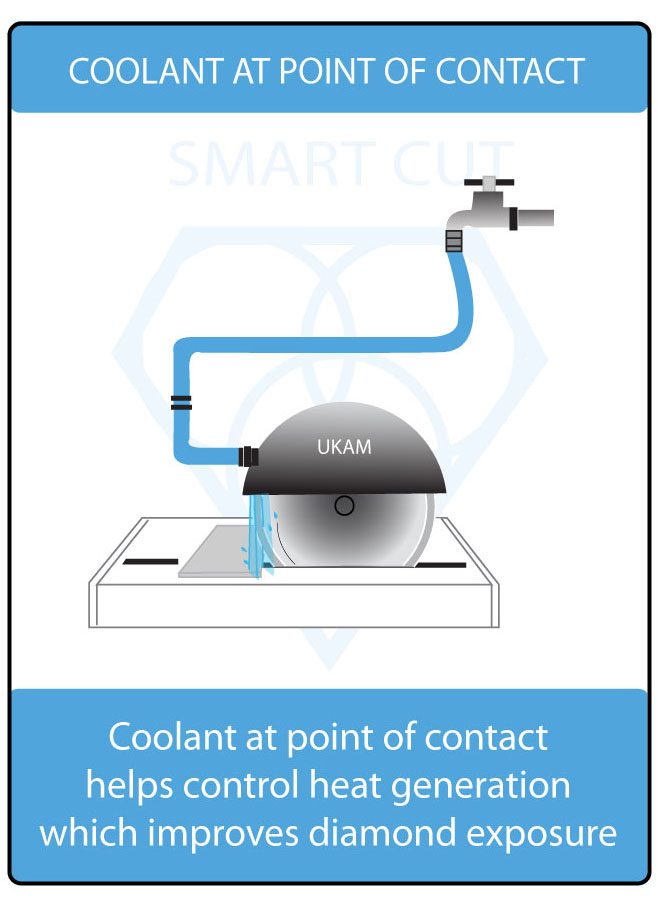
Correctly positioning the coolant nozzles is vital for directing the flow of coolant to the desired area. The nozzles should be aligned such that the coolant is directed precisely at the cutting zone. This involves adjusting the nozzle angle and distance to ensure that the coolant flows directly onto the tool and workpiece. The ideal position of the nozzle varies based on the type of operation and the shape of the cutting tool, but generally, the coolant should flow in the same direction as the rotation of the cutting tool. This helps to minimize turbulence and ensure that the coolant penetrates the cutting zone.
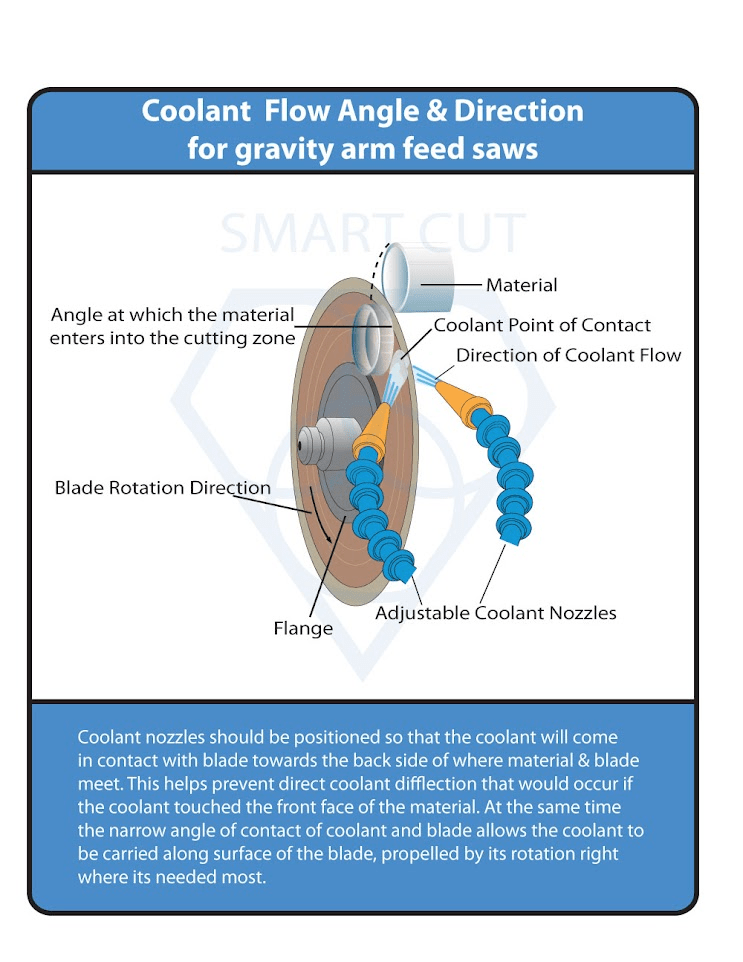
Adjusting Coolant Flow Rate
The flow rate of the coolant should be optimized to ensure that enough coolant reaches the cutting zone without excessive splashing or waste. A flow rate that is too low might not provide adequate cooling and lubrication, while a flow rate that is too high can result in splashing and coolant waste. The optimal flow rate depends on the type of operation, the speed of the cutting tool, and the thermal properties of the material being processed. It's important to monitor and adjust the flow rate to ensure that the coolant reaches the cutting zone effectively.

3. Using Directed Coolant Jets

Directed coolant jets provide a focused stream of coolant directly to the cutting zone. These jets can be adjusted for precise coolant application, ensuring that the coolant is applied where it's needed most. Directed coolant jets are particularly useful for high-speed cutting and grinding operations, where effective cooling is critical to prevent thermal damage and enhance tool performance. The jets should be positioned close to the cutting zone and adjusted to direct the coolant stream precisely onto the tool and workpiece.
4. Implementing Through-Tool Cooling
Through-tool cooling involves delivering coolant through internal channels within the cutting tool or spindle. This method provides targeted cooling directly to the cutting edge or grinding surface, ensuring that the coolant reaches the cutting zone effectively. Through-tool cooling is especially effective for precision drilling, milling, or grinding operations, where targeted cooling is essential for preventing thermal damage and ensuring high-quality finishes. By delivering the coolant internally, through-tool cooling minimizes the risk of splashing and ensures that the coolant reaches the most critical areas.
5 Using Coolant Shrouds or Enclosures
Coolant shrouds or enclosures help to contain the coolant and direct it towards the cutting zone. These shrouds are designed to fit around the cutting tool and workpiece, providing a controlled environment for coolant application. Coolant shrouds prevent the coolant from splashing away and ensure that it remains focused on the cutting zone. This method is particularly useful for high-speed or high-pressure operations, where uncontrolled coolant application can lead to splashing and coolant waste.
6. Monitoring and Adjusting Coolant Application
Regular monitoring and adjustment of the coolant application ensure that the coolant is reaching the cutting zone effectively. This includes checking the positioning of the nozzles, adjusting the flow rate, and ensuring that the coolant is being applied directly to the cutting zone. Monitoring should also involve checking for any blockages or misalignments that could affect coolant flow. By regularly monitoring and adjusting the coolant application, manufacturers and researchers can ensure that the coolant is effectively reaching the cutting zone and providing optimal cooling and lubrication.
Coolant Usage in Up Cutting and Down Cutting Operations

The choice between up cutting and down cutting in diamond tool operations significantly impacts the effectiveness of coolant application, which is crucial for cooling, lubrication, and debris removal. The direction of the cutting process affects the cutting temperatures, chip formation, and energy dissipation, all of which are influenced by the use of coolants.
Up Cutting and Coolant Usage
In up cutting, the blade enters the material tangentially, and the cutting depth increases as the blade progresses through the material. This method tends to generate slightly higher temperatures, making effective cooling essential. The coolant should be directed towards the cutting edge to manage the higher heat generated during this process.
Up cutting also provides a smoother surface finish and less material deformation, which benefits from adequate lubrication provided by the coolant. Proper lubrication reduces friction and wear on the blade, enhancing its life and maintaining the quality of the cut. The coolant should also effectively remove debris from the cutting zone, as chip formation follows the direction of the cut and tends to accumulate.
Down Cutting and Coolant Usage
In down cutting, the cutting edge of the blade initially engages with the material at maximum depth and progressively decreases as it exits. This process tends to generate lower temperatures and smaller energy dissipation, reducing the need for intensive cooling. However, the coolant should still be applied to manage the friction and wear associated with this type of cutting.
Down cutting can result in a slightly rougher surface finish, and the use of coolants with appropriate lubrication properties can mitigate this effect. The coolant should also assist in removing chips, as the chip formation aligns downward, opposite to the direction of the cut, which can impact the efficiency of debris removal.
Coolant Filtration in Diamond Tool Operations
Coolant filtration is a crucial aspect of diamond tool operations, ensuring that the coolant remains clean and effective. Proper filtration removes debris, swarf, and contaminants from the coolant, enhancing tool life and preventing issues like clogging, abrasive wear, and poor surface finishes. The quality of the coolant directly impacts the performance of the tool, the efficiency of the operation, and the quality of the finished product.
Coolant serves multiple purposes in diamond tool operations, including cooling, lubrication, and debris removal. Over time, however, the coolant can become contaminated with particles from the material being processed, as well as from the tool itself. If not properly filtered, these contaminants can lead to several issues.
One issue is clogging, where debris and swarf accumulate in the coolant system, leading to clogged nozzles or filters. Clogging can obstruct the flow of coolant to the cutting zone, reducing cooling and lubrication efficiency. Another issue is abrasive wear, where contaminants in the coolant act as abrasive particles, accelerating wear on the tool and the workpiece. Abrasive wear can reduce tool life, increase maintenance costs, and degrade the quality of the finished product. A third issue is poor surface finish, where contaminated coolant leads to surface imperfections, such as scratches or pitting, on the finished product. This is particularly problematic in precision applications, where a high-quality surface finish is crucial.
Coolant filtration systems come in various types, each designed to address specific needs and operational requirements. The choice of filtration system depends on factors such as the type of operation, the material being processed, and the type of coolant being used. Gravity filtration uses gravity to separate particles from the coolant. This system is suitable for light-duty operations with minimal debris, offering a simple and cost-effective filtration method. Magnetic filtration uses magnets to attract and remove ferrous particles from the coolant.
This system is effective for operations involving ferrous materials, such as steel, but may not capture non-ferrous debris. Bag or cartridge filtration uses disposable filters to trap particles from the coolant. This system is versatile and effective, offering varying filtration levels based on the filter type. Centrifugal filtration uses centrifugal force to separate particles from the coolant. This system is effective for removing fine particles and is suitable for high-speed or high-precision operations. Paper bed filtration uses a bed of paper to filter the coolant. This system is effective for capturing fine particles and is commonly used in grinding operations.
Regular maintenance of coolant filtration systems is essential for consistent performance and longevity. This includes cleaning, where filtration systems should be cleaned regularly to remove accumulated debris and prevent clogging. Cleaning intervals depend on the type of operation and the amount of debris generated. It also includes filter replacement, where filters in bag or cartridge systems should be replaced periodically to maintain filtration efficiency. Replacement intervals depend on the type of filter and the operational conditions. Additionally, system inspection is important, where the filtration system should be inspected regularly for wear, damage, or blockages. Inspections help identify and address issues before they impact performance or cause damage.
Coolant Water Quality & Maintenance
For most effective use of coolant the quality of water being used, coolant concentration, and maintenance of the coolant tank makes a difference. Different geographic areas have different water harnesses. Water containing less than six grains of dissolved minerals per gallon is considered soft water, water containing more than seventeen grains per gallon is considered hard. The best coolant water to use in a coolant system is chemically pure water, which is free of all dissolved solids. Chemically pure water and reverse osmosis. Reverse osmosis is the method most recommended by coolant manufacturers, however not always available. De-ionized water offers much improvement over available plant water.
Water in the tank can evaporate and remaining water can become harder. Hard water affects coolant capabilities in many ways decreased capability to the rust inhibitor, increased foaming, formation of a sticky residue, and increased bacteria counts. Coolant concentration should be controlled and maintained to ensure that the coolant is being used at optimum efficiency. Too little coolant in the tank will lead to corrosion and rancidity, while too high of a concentration can also cause foaming. Maintenance of the re-circulating tank is also critical to coolant performance. Cleaning he tank is a dirty job, but if done often enough and thoroughly, it can increase the performance of your dicing saw. Keeping he coolant tank clean will ensure that you are getting the most form your coolant, keeping corrosion and bacterial growth a bay while providing the necessary coolant, lubrication and protection of your blades and material.
Coolant Temperature and Cutting Performance
Impact of Coolant Temperature
The coolant temperature is a critical factor that influences the performance, efficiency, and longevity of diamond cutting tools. Coolant is essential in diamond cutting processes, serving multiple purposes, such as cooling the cutting area, lubricating the interface between the blade and the material, and washing away debris generated during cutting. The temperature of the coolant directly affects these functions and significantly influences the outcome of the cutting process in several ways.
Firstly, maintaining an optimal coolant temperature ensures a smoother and more precise cut, as the blade can operate at its best performance. If the coolant is too warm, it might not effectively cool the cutting area, leading to thermal damage, micro-cracking, or material deformation, which compromises cut quality.
Secondly, proper cooling prevents excessive heat buildup, which can cause premature wear or damage to the diamond segments or the bonding matrix. Overheating due to inadequate cooling can result in glazing or rapid wear, reducing the overall lifespan of the cutting tool.
Lastly, adequate cooling facilitates efficient cutting by reducing friction and keeping the blade at an optimal temperature, which in turn maintains a consistent cutting rate and reduces power consumption. Insufficient cooling due to high coolant temperatures can increase friction and heat, requiring more power for cutting and slowing down the process.
Optimal Coolant Temperature
The choice of coolant temperature is vital for balancing performance and tool longevity. The optimal coolant temperature is typically around 50 degrees Fahrenheit (10 degrees Celsius). This temperature range is generally effective for most cutting applications and helps to balance the need for cooling, lubrication, and debris removal.

However, coolant temperatures above 80 degrees Fahrenheit (27 degrees Celsius) should be avoided, as high coolant temperatures may not effectively dissipate the heat generated during cutting, leading to thermal damage to both the blade and the material being cut. Excessive heat can cause the diamond segments to detach from the blade or result in excessive wear, shortening the blade's useful life.
Coolant Temperature Control
Maintaining the appropriate coolant temperature requires attention to several factors. Proper cooling systems should be employed to regulate the coolant temperature, such as chillers or heat exchangers, to keep the temperature within the desired range. Additionally, ensuring adequate flow of coolant over the cutting area is crucial for effective heat dissipation, as the coolant should cover the cutting zone thoroughly to prevent localized heating.
Regular monitoring of the coolant temperature can help prevent overheating or inefficient cooling, ensuring consistent cutting performance. Furthermore, ambient temperature can also influence coolant temperature, so adjustments may be needed based on the operating environment to maintain optimal conditions.





